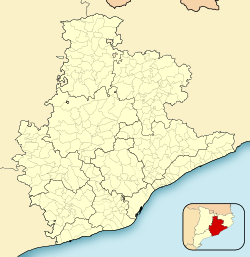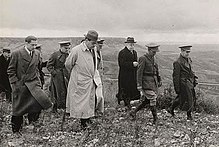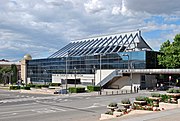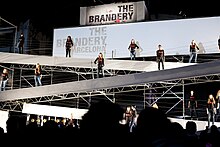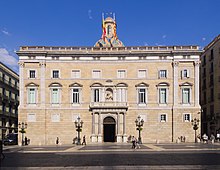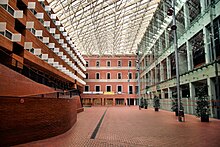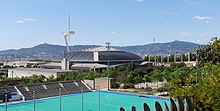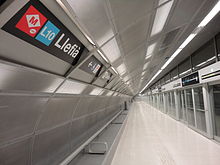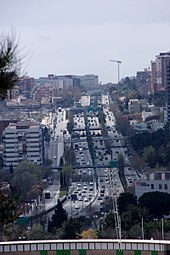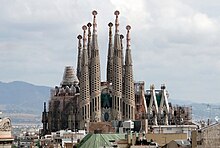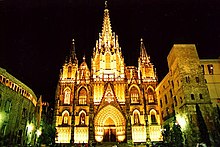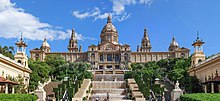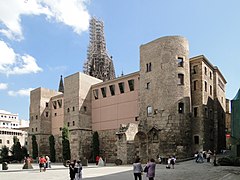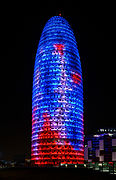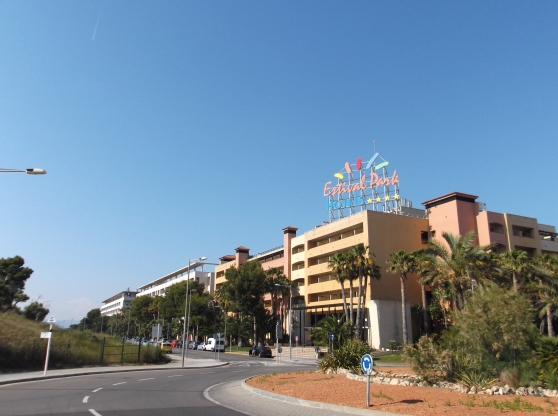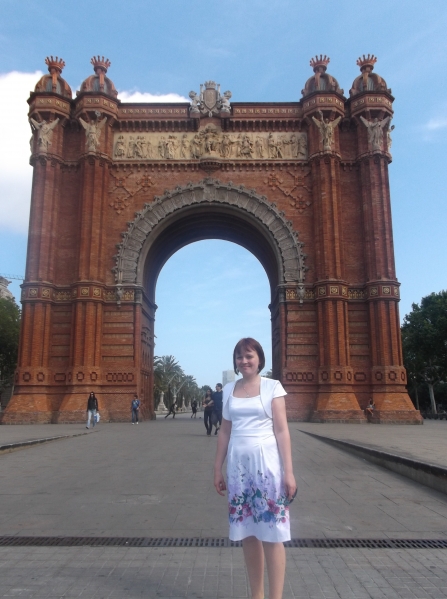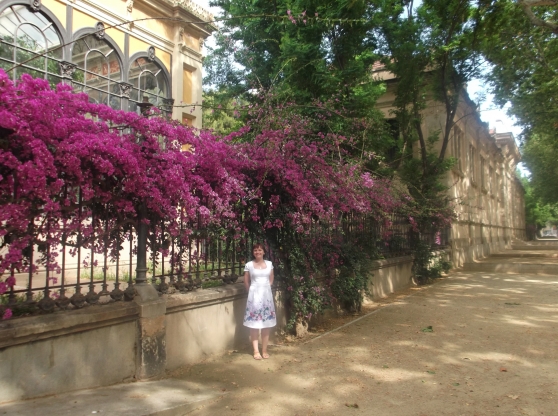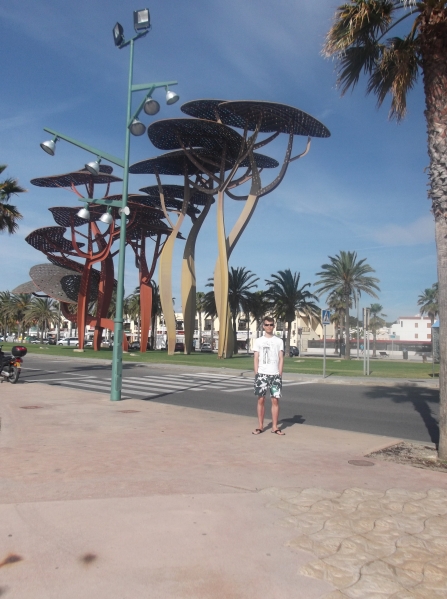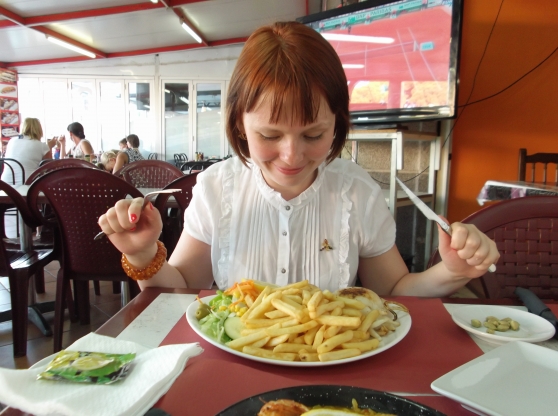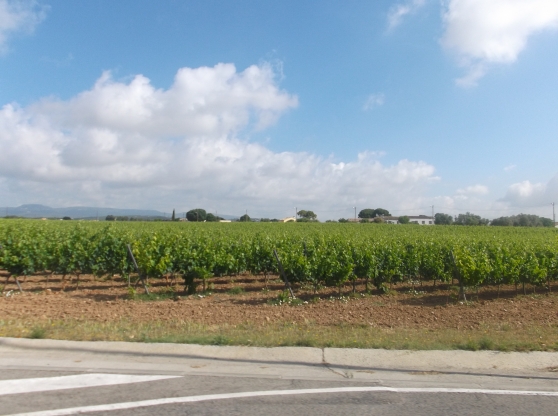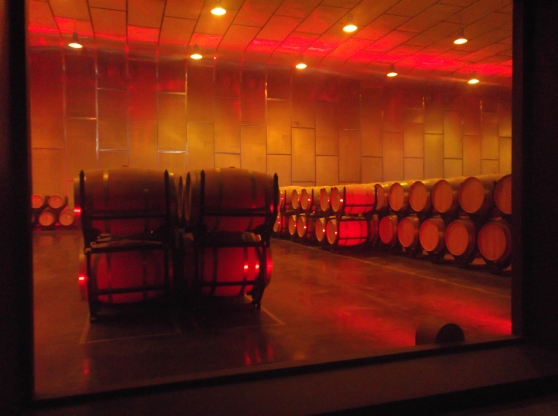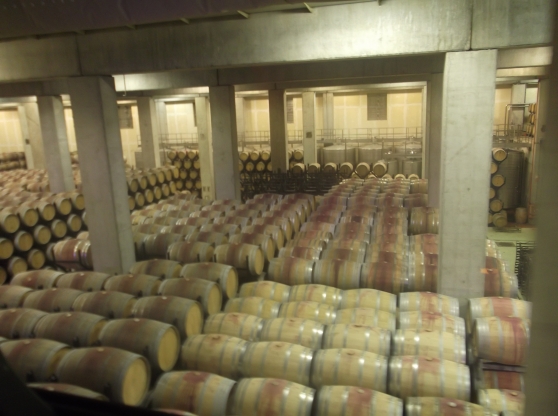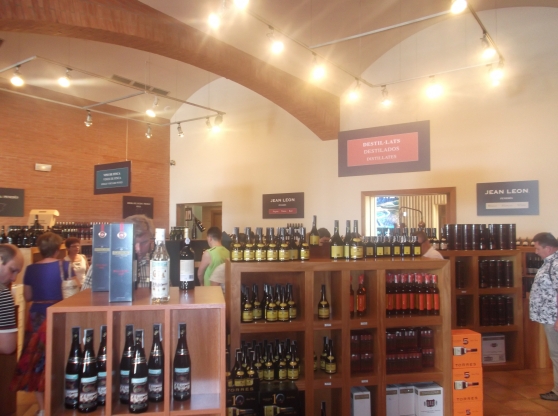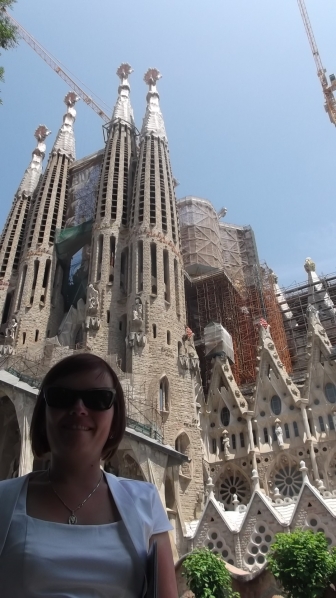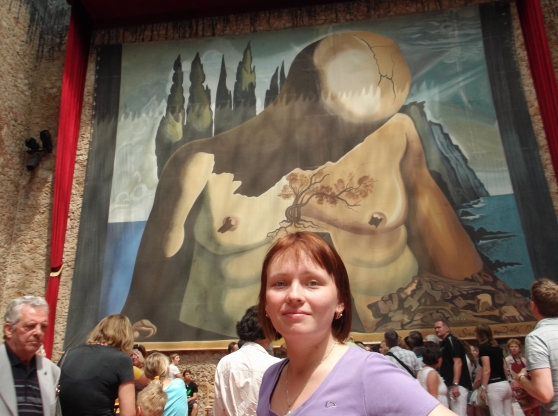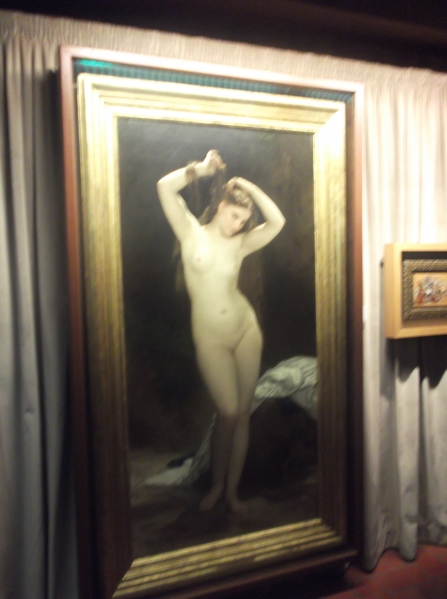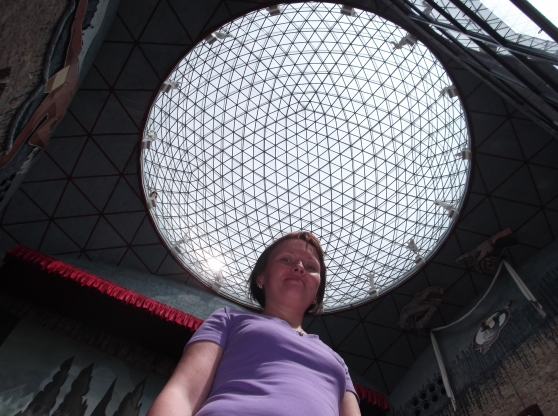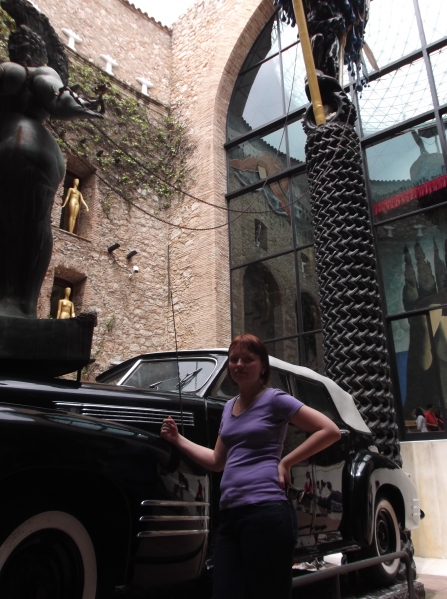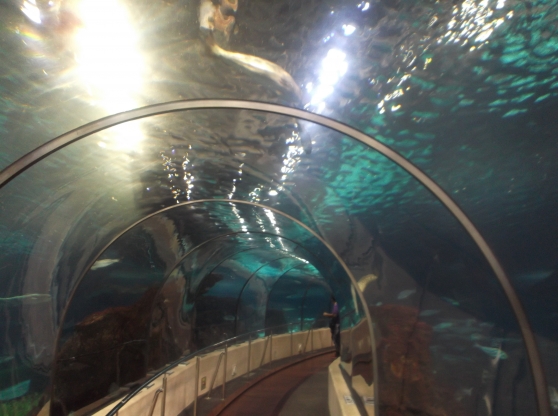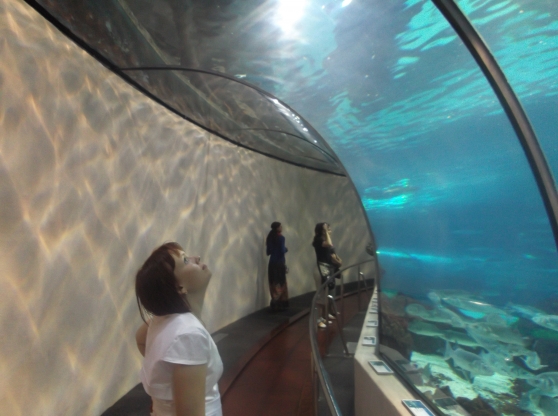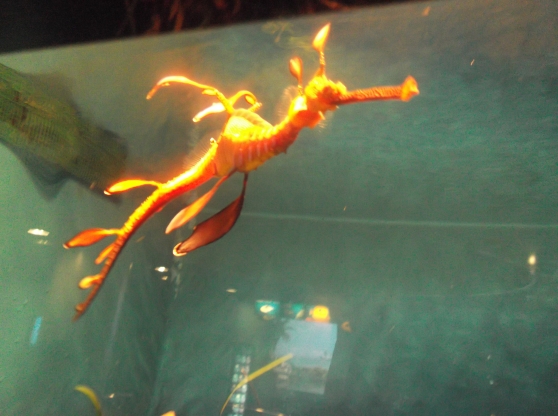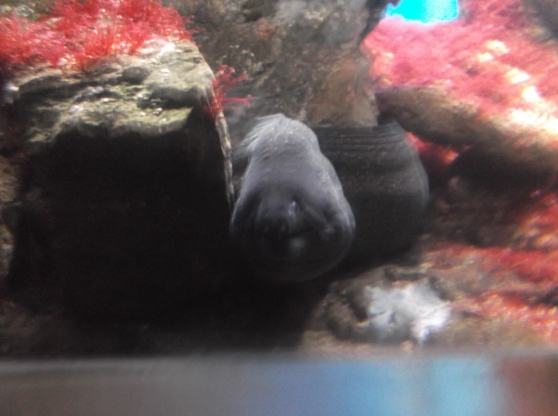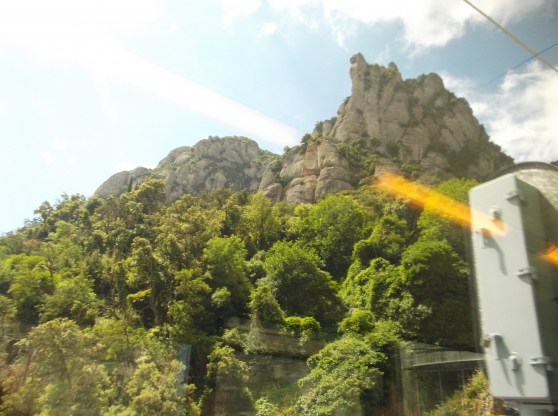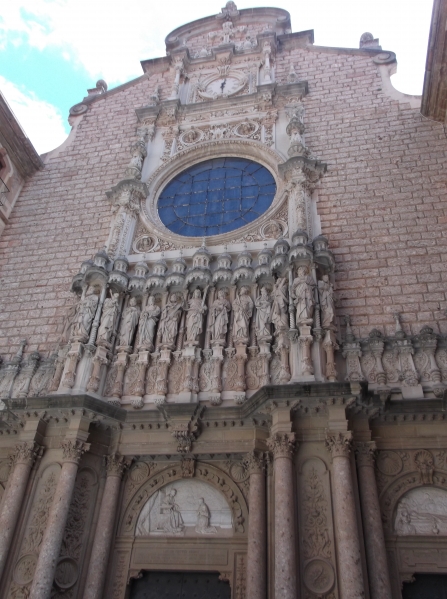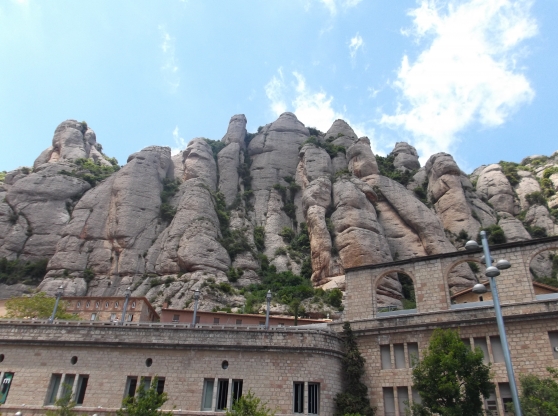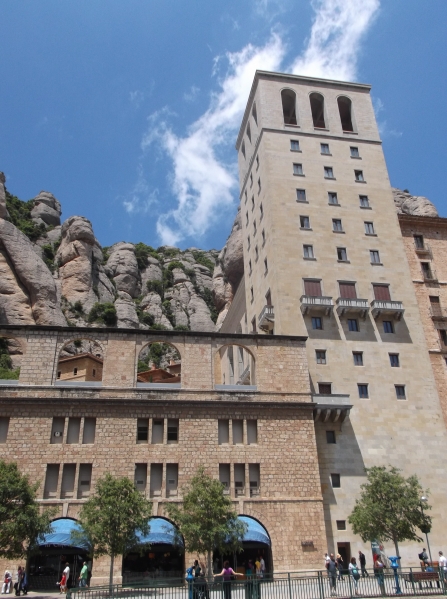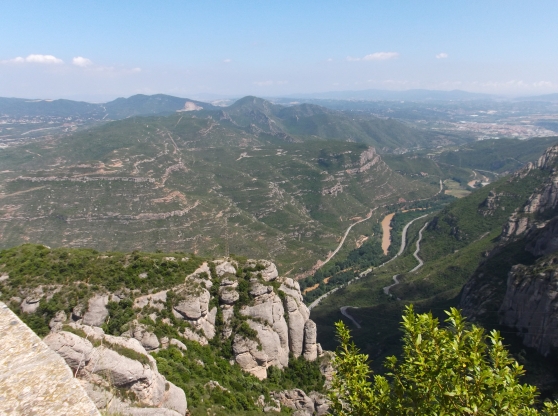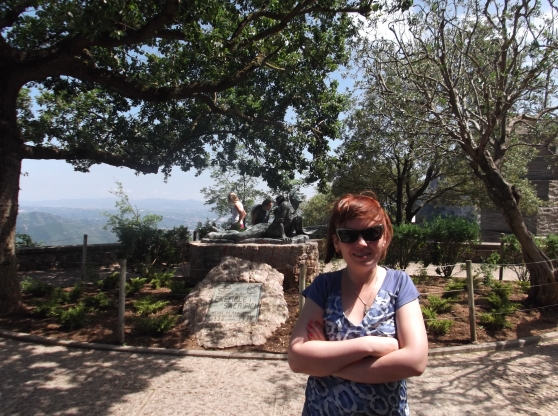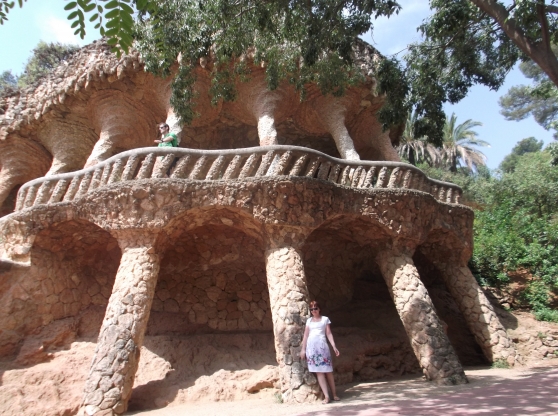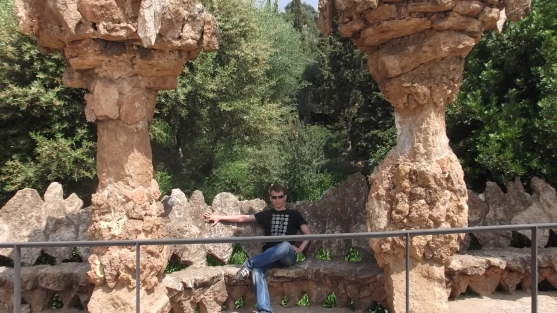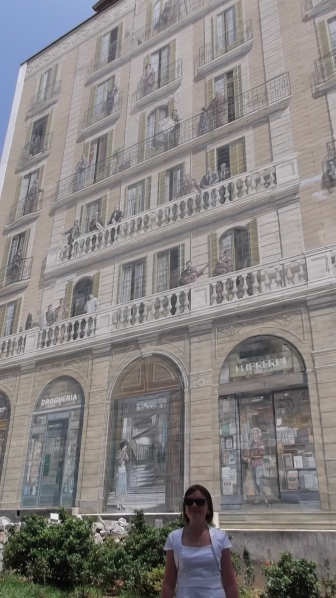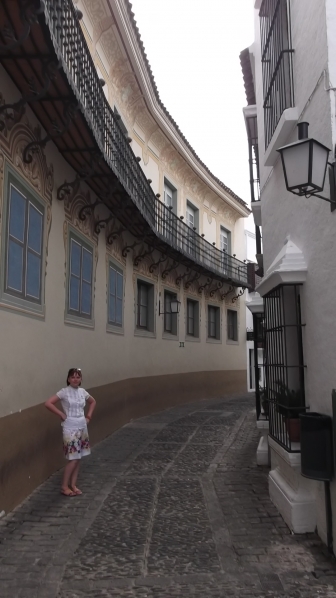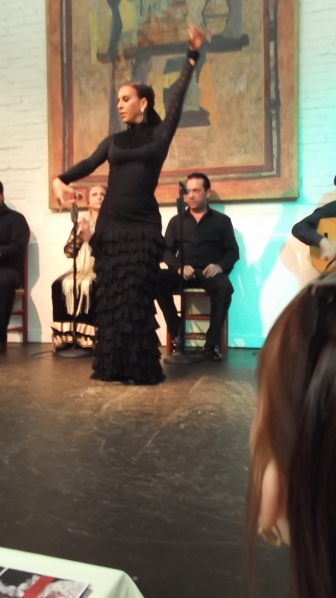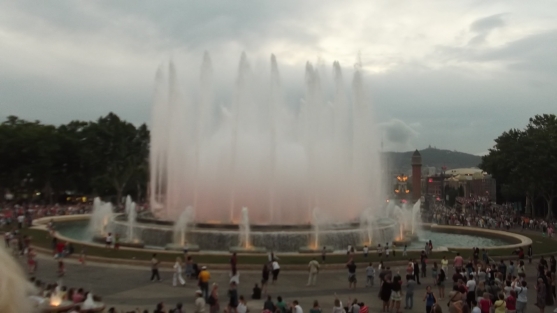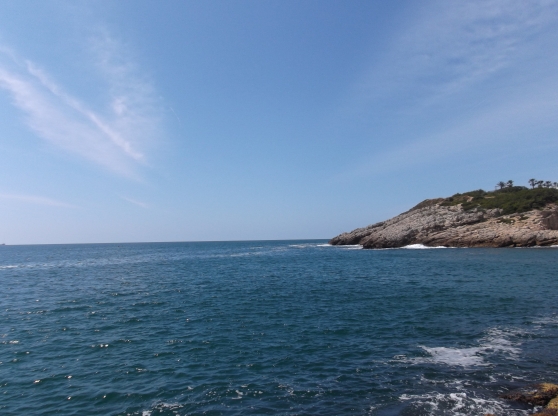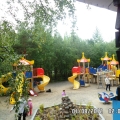Мой любимый город — Барселона; My favourite city is Barcelona — Топик по английскому языку
- 13.11.2018
Тема по английскому языку: Мой любимый город — Барселона
Топик по английскому языку: Барселона (My favourite city is Barcelona). Данный текст может быть использован в качестве презентации, проекта, рассказа, эссе, сочинения или сообщения на тему.
Основная информация
Барселона – второй по величине город в Испании и столица автономной территории Каталонии. Она расположена на северо-восточном побережье Иберийского полуострова и омывается Средиземным морем. Население города составляет 1 621 537 человек. Барселона поделена на 10 административных районов, каждый со своим местным органом самоуправления. Это двуязычный город, где официальными языками являются каталанский и испанский.
Климат
В Барселоне средиземноморский климат с умеренными и влажными зимами и теплым, сухим летом. Когда в город приходят атлантические западные ветра, там нет дождей. Однако, в августе, сентябре, октябре и ноябре выпадает больше всего осадков. Самые сухие месяцы – февраль, март, июнь и июль.
Центр
Барселона – это важный финансовый, коммерческий, культурный и образовательный центр.
Экономика
Что касается здешней экономики, то имеется два главных сектора – промышленный и сфера обслуживания. Благодаря традиции искусства и ремесел, Барселона известна своим производственным дизайном.
Промышленность
Главные индустрии города – это текстильная, химическая, электронная, логистика, печатная, телекоммуникационная и некоторые другие. Аэропорт Барселоны – второй по величине аэропорт в Испании и самый большой на средиземноморском побережье. Барселона также является морским портом огромной коммерческой важности.
Сultural centre
Культуре Барселоны около 2000 лет. В городе большое количество театров и музеев. Самые известные из них – это Национальный театр Каталонии, Национальный музей искусства Каталонии, Барселонский музей современного искусства и некоторые другие.
Спорт
Барселона поддерживает долголетние спортивные традиции. Футбольный клуб «Барселона» известен во всем мире своей футбольной командой и является одним из крупнейших в Европе.
Заключение
Этот красивый испанский город действительно стоит посетить.
Скачать Топик по английскому языку: Барселона
General information
Barcelona is the second largest city in Spain and the capital of Autonomous Community of Catalonia. It is situated on the northeast coast of the Iberian Peninsula and washed by the Mediterranean Sea. The population of the city is 1,621,537 people. Barcelona is divided into 10 administrative districts, each with its own council. It’s a bilingual city with Catalan and Spanish as official languages.
Climate
Barcelona has a Mediterranean climate with mild and humid winters and warm, dry summers. There are no rains when Atlantic west winds arrive in the city. August, September, October and November are the wettest months of the year. The driest are February, March, June and July.
Centre
Barcelona is an important financial, commercial, cultural and educational centre.
Economy
Regarding its economy, there are two main sectors – the manufacturing and the services. Due to Barcelona’s tradition of creative art and craftsmanship, the city is famous for its award-winning industrial design.
Main industries
The city’s main industries are textiles, chemical, electronic, printing, logistics, publishing, telecommunications and some others. Barcelona’s airport is the second largest airport in Spain, and the largest on the Mediterranean coast. Barcelona is also a big seaport of a great commercial importance.
Culture
Barcelona’s culture is about 2000 years old. There are a great number of theatres and museums in the city. The most famous are Teatre Nacional de Catalunya, the National Museum of Art of Catalonia, Barcelona Museum of Contemporary Art and some others.
Sport
Barcelona has a long-standing sporting tradition. Football club “Barcelona” is known all over the world for its football team as it’s one of the largest in Europe.
Conclusion
This nice Spanish city is really worth visiting.
|
Barcelona |
|
|---|---|
|
City and municipality |
|

From the top: 22@ new business district, Sagrada Família, Camp Nou, Castle of the Three Dragons, Palau Nacional, W Barcelona hotel and beach |
|
|
Flag Coat of arms |
|
| Nicknames:
Ciutat Comtal (Catalan) Cap i Casal de Catalunya (Catalan) Abbreviation(s): |
|
|
Location in the Province of Barcelona Location in Catalonia Location in Spain Location in Europe |
|
| Coordinates: 41°23′N 2°11′E / 41.383°N 2.183°ECoordinates: 41°23′N 2°11′E / 41.383°N 2.183°E | |
| Country | |
| Autonomous community | |
| Province | Barcelona |
| Comarca | Barcelonès |
| Districts |
10
|
| Government | |
| • Type | Ayuntamiento |
| • Body | Ajuntament de Barcelona |
| • Mayor | Ada Colau Ballano[1] (Barcelona en Comú) |
| Area
[2] |
|
| • City | 101.4 km2 (39.2 sq mi) |
| Elevation
(AMSL) |
12 m (39 ft) |
| Population
(2018)[5] |
|
| • City | 1,620,343 |
| • Rank | 2nd |
| • Density | 16,000/km2 (41,000/sq mi) |
| • Urban | 4,840,000[3] |
| • Metro | 5,474,482[4] |
| Demonyms | Barcelonan, Barcelonian barceloní, -ina (Catalan) barcelonés, -esa (Spanish) |
| Postal code |
080xx |
| Area code | +34 (E) 93 (B) |
| INE code | 08 0193 |
| City budget (2021) | €2.4 billion[6] |
| Official language | Catalan and Spanish |
| Main festivity | La Mercè |
| Patron saint | Eulalia of Barcelona |
| Website | www.barcelona.cat |
 |
|
| Click on the map for a fullscreen view |
Barcelona ( BAR-sə-LOH-nə, Catalan: [bəɾsəˈlonə], Spanish: [baɾθeˈlona]) is a city on the coast of northeastern Spain. It is the capital and largest city of the autonomous community of Catalonia, as well as the second most populous municipality of Spain. With a population of 1.6 million within city limits,[7] its urban area extends to numerous neighbouring municipalities within the Province of Barcelona and is home to around 4.8 million people,[3] making it the fifth most populous urban area in the European Union after Paris, the Ruhr area, Madrid, and Milan.[3] It is one of the largest metropolises on the Mediterranean Sea, located on the coast between the mouths of the rivers Llobregat and Besòs, and bounded to the west by the Serra de Collserola mountain range, the tallest peak of which is 512 metres (1,680 feet) high.
Founded as a Roman city, in the Middle Ages Barcelona became the capital of the County of Barcelona. After joining with the Kingdom of Aragon to form the confederation of the Crown of Aragon, Barcelona, which continued to be the capital of the Principality of Catalonia, became the most important city in the Crown of Aragon and the main economic and administrative centre of the Crown, only to be overtaken by Valencia, wrested from Arab domination by the Catalans, shortly before the dynastic union between the Crown of Castile and the Crown of Aragon in 1492. Barcelona has a rich cultural heritage and is today an important cultural centre and a major tourist destination. Particularly renowned are the architectural works of Antoni Gaudí and Lluís Domènech i Montaner, which have been designated UNESCO World Heritage Sites. The city is home to two of the most prestigious universities in Spain: the University of Barcelona and Pompeu Fabra University. The headquarters of the Union for the Mediterranean are located in Barcelona. The city is known for hosting the 1992 Summer Olympics as well as world-class conferences and expositions and also many international sport tournaments.
Barcelona is a major cultural, economic, and financial centre in southwestern Europe,[8] as well as the main biotech hub in Spain.[9] As a leading world city, Barcelona’s influence in global socio-economic affairs qualifies it for global city status (Beta +).[10]
Barcelona is a transport hub, with the Port of Barcelona being one of Europe’s principal seaports and busiest European passenger port,[11] an international airport, Barcelona–El Prat Airport, which handles over 50 million passengers per year,[12] an extensive motorway network, and a high-speed rail line with a link to France and the rest of Europe.[13]
Names
The name Barcelona comes from the ancient Iberian Baŕkeno, attested in an ancient coin inscription found on the right side of the coin in Iberian script as ,[14] in ancient Greek sources as Βαρκινών, Barkinṓn;[15][16] and in Latin as Barcino,[17] Barcilonum[18] and Barcenona.[19][20][21]
Some older sources suggest that the city may have been named after the Carthaginian general Hamilcar Barca, who was supposed to have founded the city in the 3rd century BC,[22] but there is no evidence that Barcelona was ever a Carthaginian settlement, or that its name in antiquity, Barcino, had any connection with the Barcid family of Hamilcar.[23]
During the Middle Ages, the city was variously known as Barchinona, Barçalona, Barchelonaa, and Barchenona.
Internationally,[citation needed] Barcelona’s name is abbreviated colloquially to ‘Barça’ in reference to the football club FC Barcelona, whose anthem is the Cant del Barça «Barça chant». A common abbreviated form used by locals for the city is Barna.
Another common abbreviation is ‘BCN’, which is also the IATA airport code of the Barcelona-El Prat Airport.
The city is referred to as the Ciutat Comtal in Catalan and Ciudad Condal in Spanish (i.e., «Comital City» or «City of Counts»), owing to its past as the seat of the Count of Barcelona.[24]
History
A marble plaque in the Museu d’Història de la Ciutat de Barcelona, dated from around 110–130 AD and dedicated to the Roman colony of Barcino
Pre-history
The origin of the earliest settlement at the site of present-day Barcelona is unclear. The ruins of an early settlement have been
found, including different tombs and dwellings dating to earlier than 5000 BC.[25][26] The founding of Barcelona is the subject of two different legends. The first attributes the founding of the city to the mythological Hercules. The second legend attributes the foundation of the city directly to the historical Carthaginian general, Hamilcar Barca, father of Hannibal, who supposedly named the city Barcino after his family in the 3rd century BC,[27] but there is no historical or linguistic evidence that this is true.[23] Archeological evidence in the form of coins from the 3rd Century BC have been found on the hills at the foot of Montjuïc with the name Bárkeno written in an ancient script in the Iberian language. Thus, we can conclude that the Laietani, an ancient Iberian (Pre-Roman) people of the Iberian peninsula, who inhabited the area occupied by the city of Barcelona around 3 – 2 BC, called the area Bàrkeno, which means «The Place of the Plains» (Barrke = plains/terrace).[28]
Roman Barcelona
In about 15 BC, the Romans redrew the town as a castrum (Roman military camp) centred on the «Mons Taber«, a little hill near the Generalitat (Catalan Government) and city hall buildings. The Roman Forum, at the crossing of the Cardo Maximus and Decumanus Maximus, was approximately placed where current Plaça de Sant Jaume is. Thus, the political center of the city, Catalonia, and its domains has remained in the same place for over 2000 years.
Under the Romans, it was a colony with the surname of Faventia,[29] or, in full, Colonia Faventia Julia Augusta Pia Barcino[30] or Colonia Julia Augusta Faventia Paterna Barcino. Pomponius Mela[31] mentions it among the small towns of the district, probably as it was eclipsed by its neighbour Tarraco (modern Tarragona), but it may be gathered from later writers that it gradually grew in wealth and consequence, favoured as it was with a beautiful situation and an excellent harbour.[32] It enjoyed immunity from imperial burdens.[33] The city minted its own coins; some from the era of Galba survive.
Important Roman vestiges are displayed in Plaça del Rei underground, as a part of the Barcelona City History Museum (MUHBA); the typically Roman grid plan is still visible today in the layout of the historical centre, the Barri Gòtic (Gothic Quarter). Some remaining fragments of the Roman walls have been incorporated into the cathedral.[34] The cathedral, known very formally by the long name of Catedral Basílica Metropolitana de Barcelona, is also sometimes called La Seu, which simply means cathedral (and see, among other things) in Catalan.[35][36] It is said to have been founded in 343.
Medieval Barcelona
The city was conquered by the Visigoths in the early 5th century, becoming for a few years the capital of all Hispania. After being conquered by the Arabs in the early 8th century, it was conquered after a siege in 801 by Charlemagne’s son Louis, who made Barcelona the seat of the Carolingian «Hispanic March» (Marca Hispanica), a buffer zone ruled by the Count of Barcelona.[37]
The Counts of Barcelona became increasingly independent and expanded their territory to include much of modern Catalonia, although on 6 July 985, Barcelona was sacked by the army of Almanzor.[38] The sack was so traumatic that most of Barcelona’s population was either killed or enslaved.[39] In 1137, Aragon and the County of Barcelona merged in dynastic union[40][41] by the marriage of Ramon Berenguer IV and Petronilla of Aragon, their titles finally borne by only one person when their son Alfonso II of Aragon ascended to the throne in 1162. His territories were later to be known as the Crown of Aragon, which conquered many overseas possessions and ruled the western Mediterranean Sea with outlying territories in Naples and Sicily and as far as Athens in the 13th century.
Barcelona was the leading slave trade centre of the Crown of Aragon up until the 15th century, when it was eclipsed by Valencia.[42] It initially fed from eastern and balkan slave stock later drawing from a Maghribian and, ultimately, Subsaharan pool of slaves.[43]
The Bank of Barcelona or Taula de canvi, often viewed as the oldest public bank in Europe, was established by the city magistrates in 1401. It originated from necessities of the state, as did the Bank of Venice (1402) and the Bank of Genoa (1407).[44]
Barcelona under the Spanish monarchy
The marriage of Ferdinand II of Aragon and Isabella I of Castile in 1469 united the two royal lines. Madrid became the centre of political power whilst the colonisation of the Americas reduced the financial importance (at least in relative terms) of Mediterranean trade. Barcelona was a centre of Catalan separatism, including the Catalan Revolt (1640–52) against Philip IV of Spain. The great plague of 1650–1654 halved the city’s population.[45]
In the 18th century, a fortress was built at Montjuïc that overlooked the harbour. In 1794, this fortress was used by the French astronomer Pierre François André Méchain for observations relating to a survey stretching to Dunkirk that provided the official basis of the measurement of a metre.[46] The definitive metre bar, manufactured from platinum, was presented to the French legislative assembly on 22 June 1799. Much of Barcelona was negatively affected by the Napoleonic wars, but the start of industrialisation saw the fortunes of the province improve.
The Spanish Civil War and the Franco period
Barcelona was the capital of the Republic of Spain from November 1937 until January 1939.[47][48] During that Spanish Civil War period, both Barcelona and Madrid were still under the rule of the republic. In the image Azaña and Negrín on the city outskirts.
During the Spanish Civil War, the city, and Catalonia in general, were resolutely Republican. Many enterprises and public services were collectivised by the CNT and UGT unions. As the power of the Republican government and the Generalitat diminished, much of the city was under the effective control of anarchist groups. The anarchists lost control of the city to their own allies, the Communists and official government troops, after the street fighting of the Barcelona May Days. The fall of the city on 26 January 1939, caused a mass exodus of civilians who fled to the French border. The resistance of Barcelona to Franco’s coup d’état was to have lasting effects after the defeat of the Republican government. The autonomous institutions of Catalonia were abolished,[49] and the use of the Catalan language in public life was suppressed. Barcelona remained the second largest city in Spain, at the heart of a region which was relatively industrialised and prosperous, despite the devastation of the civil war. The result was a large-scale immigration from poorer regions of Spain (particularly Andalusia, Murcia and Galicia), which in turn led to rapid urbanisation.
Late twentieth century
In 1992, Barcelona hosted the Summer Olympics. The after-effects of this are credited with driving major changes in what had, up until then, been a largely industrial city. As part of the preparation for the games, industrial buildings along the sea-front were demolished and 3 kilometres (2 miles) of beach were created. New construction increased the road capacity of the city by 17%, the sewage handling capacity by 27% and the amount of new green areas and beaches by 78%. Between 1990 and 2004, the number of hotel rooms in the city doubled. Perhaps more importantly, the outside perception of the city was changed making, by 2012, Barcelona the 12th most popular city destination in the world and the 5th amongst European cities.[50][51][52][53][54]
Recent history
Protest against independence in October 2017
The death of Franco in 1975 brought on a period of democratisation throughout Spain. Pressure for change was particularly strong in Barcelona, which considered that it had been punished during nearly forty years of Francoism for its support of the Republican government.[55] Massive, but peaceful, demonstrations on 11 September 1977 assembled over a million people in the streets of Barcelona to call for the restoration of Catalan autonomy. It was granted less than a month later.[56]
The development of Barcelona was promoted by two events in 1986: Spanish accession to the European Community, and particularly Barcelona’s designation as host city of the 1992 Summer Olympics.[57][58] The process of urban regeneration has been rapid, and accompanied by a greatly increased international reputation of the city as a tourist destination. The increased cost of housing has led to a slight decline (−16.6%) in the population over the last two decades of the 20th century as many families move out into the suburbs. This decline has been reversed since 2001, as a new wave of immigration (particularly from Latin America and from Morocco) has gathered pace.[59]
In 1987, an ETA car bombing at Hipercor killed 21 people. On 17 August 2017, a van was driven into pedestrians on La Rambla, killing 14 and injuring at least 100, one of whom later died. Other attacks took place elsewhere in Catalonia. The Prime Minister of Spain, Mariano Rajoy, called the attack in Barcelona a jihadist attack. Amaq News Agency attributed indirect responsibility for the attack to the Islamic State of Iraq and the Levant (ISIL).[60][61][62] During the 2010s, Barcelona became the focus city[citation needed] for the ongoing Catalan independence movement, its consequent standoff between the regional and national government and later protests.[63]
Geography
A panoramic view of Barcelona
Location
Barcelona is located on the northeast coast of the Iberian Peninsula, facing the Mediterranean Sea, on a plain approximately 5 km (3 mi) wide limited by the mountain range of Collserola, the Llobregat river to the southwest and the Besòs river to the north.[64] This plain covers an area of 170 km2 (66 sq mi),[64] of which 101 km2 (39.0 sq mi)[65] are occupied by the city itself. It is 120 kilometres (75 miles) south of the Pyrenees and the Catalan border with France.
Tibidabo, 512 m (1,680 ft) high, offers striking views over the city[66] and is topped by the 288.4 m (946.2 ft) Torre de Collserola, a telecommunications tower that is visible from most of the city. Barcelona is peppered with small hills, most of them urbanised, that gave their name to the neighbourhoods built upon them, such as Carmel (267 metres or 876 feet), Putget (es) (181 metres or 594 feet) and Rovira (261 metres or 856 feet). The escarpment of Montjuïc (173 metres or 568 feet), situated to the southeast, overlooks the harbour and is topped by Montjuïc Castle, a fortress built in the 17–18th centuries to control the city as a replacement for the Ciutadella. Today, the fortress is a museum and Montjuïc is home to several sporting and cultural venues, as well as Barcelona’s biggest park and gardens.
The city borders on the municipalities of Santa Coloma de Gramenet and Sant Adrià de Besòs to the north; the Mediterranean Sea to the east; El Prat de Llobregat and L’Hospitalet de Llobregat to the south; and Sant Feliu de Llobregat, Sant Just Desvern, Esplugues de Llobregat, Sant Cugat del Vallès, and Montcada i Reixac to the west. The municipality includes two small sparsely-inhabited exclaves to the north-west.
Climate
According to the Köppen climate classification, Barcelona has a hot summer Mediterranean climate (Csa), with mild winters and warm to hot summers,[67] while the rainiest seasons are autumn and spring. The rainfall pattern is characterised by a short (3 months) dry season in summer, as well as less winter rainfall than in a typical Mediterranean climate. However, both June and August are wetter than February, which is unusual for the Mediterranean climate. This subtype, labelled as «Portuguese» by the French geographer George Viers after the climate classification of Emmanuel de Martonne[68] and found in the NW Mediterranean area (e.g. Marseille), can be seen as transitional to the humid subtropical climate (Cfa) found in inland areas.
Barcelona is densely populated, thus heavily influenced by the urban heat island effect. Areas outside of the urbanised districts can have as much as 2 °C of difference in temperatures throughout the year.[69] Its average annual temperature is 21.2 °C (70.2 °F) during the day and 15.1 °C (59.2 °F) at night. The average annual temperature of the sea is about 20 °C (68 °F). In the coldest month, January, the temperature typically ranges from 12 to 18 °C (54 to 64 °F) during the day, 6 to 12 °C (43 to 54 °F) at night and the average sea temperature is 13 °C (55 °F).[70] In the warmest month, August, the typical temperature ranges from 27 to 31 °C (81 to 88 °F) during the day, about 23 °C (73 °F) at night and the average sea temperature is 26 °C (79 °F).[70] Generally, the summer or «holiday» season lasts about six months, from May to October. Two months – April and November – are transitional; sometimes the temperature exceeds 20 °C (68 °F), with an average temperature of 18–19 °C (64–66 °F) during the day and 11–13 °C (52–55 °F) at night. December, January and February are the coldest months, with average temperatures around 15 °C (59 °F) during the day and 9 °C (48 °F) at night. Large fluctuations in temperature are rare, particularly in the summer months. Because of the proximity to the warm sea plus the urban heat island, frosts are very rare in the city of Barcelona. Snow is also very infrequent in the city of Barcelona, but light snowfalls can occur yearly in the nearby Collserola mountains, such as in the Fabra Observatory located in a nearby mountain.[71]
Barcelona averages 78 rainy days per year (≥ 1 mm), and annual average relative humidity is 72%, ranging from 69% in July to 75% in October. Rainfall totals are highest in late summer and autumn (September–November) and lowest in early and mid-summer (June–August), with a secondary winter minimum (February–March). Sunshine duration is 2,524 hours per year, from 138 (average 4.5 hours of sunshine a day) in December to 310 (average 10 hours of sunshine a day) in July.[72]
| Climate data for Barcelona Can Bruixa – Barcelona (1987–2010) | |||||||||||||
|---|---|---|---|---|---|---|---|---|---|---|---|---|---|
| Month | Jan | Feb | Mar | Apr | May | Jun | Jul | Aug | Sep | Oct | Nov | Dec | Year |
| Average high °C (°F) | 14.8 (58.6) |
15.6 (60.1) |
17.4 (63.3) |
19.1 (66.4) |
22.5 (72.5) |
26.1 (79.0) |
28.6 (83.5) |
29.0 (84.2) |
26.0 (78.8) |
22.5 (72.5) |
17.9 (64.2) |
15.1 (59.2) |
21.2 (70.2) |
| Daily mean °C (°F) | 11.8 (53.2) |
12.4 (54.3) |
14.2 (57.6) |
15.8 (60.4) |
19.3 (66.7) |
22.9 (73.2) |
25.7 (78.3) |
26.1 (79.0) |
23.0 (73.4) |
19.5 (67.1) |
14.9 (58.8) |
12.3 (54.1) |
18.2 (64.8) |
| Average low °C (°F) | 8.8 (47.8) |
9.3 (48.7) |
10.9 (51.6) |
12.5 (54.5) |
16.1 (61.0) |
19.8 (67.6) |
22.7 (72.9) |
23.1 (73.6) |
20.0 (68.0) |
16.5 (61.7) |
11.9 (53.4) |
9.5 (49.1) |
15.1 (59.2) |
| Average precipitation mm (inches) | 43.7 (1.72) |
31.4 (1.24) |
33.0 (1.30) |
47.7 (1.88) |
47.4 (1.87) |
32.5 (1.28) |
25.1 (0.99) |
40.8 (1.61) |
81.9 (3.22) |
96.5 (3.80) |
45.1 (1.78) |
46.8 (1.84) |
571.9 (22.53) |
| Average precipitation days (≥ 1 mm) | 7.0 | 5.0 | 6.2 | 7.9 | 7.5 | 5.5 | 3.1 | 5.8 | 8.0 | 9.0 | 6.6 | 7.0 | 78.6 |
| Mean monthly sunshine hours | 149 | 163 | 200 | 220 | 244 | 262 | 310 | 282 | 219 | 180 | 146 | 138 | 2,524 |
| Source 1: Servei Meteorològic de Catalunya[73] | |||||||||||||
| Source 2: Agencia Estatal de Meteorología (sunshine hours)[citation needed] |
| Climate data for El Prat de Llobregat (Barcelona–El Prat Airport) (1981-2010) at 15 kilometres (9.3 mi)) from the city centre of Barcelona. | |||||||||||||
|---|---|---|---|---|---|---|---|---|---|---|---|---|---|
| Month | Jan | Feb | Mar | Apr | May | Jun | Jul | Aug | Sep | Oct | Nov | Dec | Year |
| Average high °C (°F) | 13.6 (56.5) |
14.3 (57.7) |
16.1 (61.0) |
18.0 (64.4) |
21.1 (70.0) |
24.9 (76.8) |
28.0 (82.4) |
28.5 (83.3) |
26.0 (78.8) |
22.1 (71.8) |
17.3 (63.1) |
14.3 (57.7) |
20.3 (68.5) |
| Daily mean °C (°F) | 9.2 (48.6) |
9.9 (49.8) |
11.8 (53.2) |
13.7 (56.7) |
16.9 (62.4) |
20.9 (69.6) |
23.9 (75.0) |
24.4 (75.9) |
21.7 (71.1) |
17.8 (64.0) |
13.0 (55.4) |
10.0 (50.0) |
16.1 (61.0) |
| Average low °C (°F) | 4.7 (40.5) |
5.4 (41.7) |
7.4 (45.3) |
9.4 (48.9) |
12.8 (55.0) |
16.8 (62.2) |
19.8 (67.6) |
20.2 (68.4) |
17.4 (63.3) |
13.5 (56.3) |
8.6 (47.5) |
5.7 (42.3) |
11.8 (53.2) |
| Average precipitation mm (inches) | 37 (1.5) |
35 (1.4) |
36 (1.4) |
40 (1.6) |
47 (1.9) |
30 (1.2) |
21 (0.8) |
62 (2.4) |
81 (3.2) |
91 (3.6) |
59 (2.3) |
40 (1.6) |
588 (23.1) |
| Average precipitation days (≥ 1 mm) | 4 | 4 | 5 | 5 | 5 | 4 | 2 | 5 | 5 | 6 | 5 | 4 | 53 |
| Mean monthly sunshine hours | 158 | 171 | 206 | 239 | 258 | 287 | 293 | 264 | 229 | 196 | 153 | 137 | 2,591 |
| Source: Agencia Estatal de Meteorología[74] |
Demographics
Demographic evolution, 1900–2007, according to the Spanish Instituto Nacional de Estadística
According to Barcelona’s City Council, Barcelona’s population as of 1 January 2016 was 1,608,746 people,[75] on a land area of 101.4 km2 (39 sq mi). It is the main component of an administrative area of Greater Barcelona, with a population of 3,218,071 in an area of 636 square kilometres (246 square miles) (density 5,060 inhabitants/km2). The population of the urban area was 4,840,000.[3] It is the central nucleus of the Barcelona metropolitan area, which relies on a population of 5,474,482.[4]
Spanish is the most spoken language in Barcelona (according to the linguistic census held by the Government of Catalonia in 2013) and it is understood almost universally. Catalan is also very commonly spoken in the city: it is understood by 95% of the population, while 72.3% can speak it, 79% can read it, and 53% can write it.[76] Knowledge of Catalan has increased significantly in recent decades thanks to a language immersion educational system.
In 1900, Barcelona had a population of 533,000,[64] which grew steadily but slowly until 1950, when it started absorbing a high number of people from other less-industrialised parts of Spain. Barcelona’s population peaked in 1979 at 1,906,998, and fell throughout the 1980s and 1990s as more people sought a higher quality of life in outlying cities in the Barcelona Metropolitan Area. After bottoming out in 2000 with 1,496,266 residents, the city’s population began to rise again as younger people started to return, causing a great increase in housing prices.[77]
Population density
Note: This text is entirely based on the municipal statistical database provided by the city council.
Barcelona is one of the most densely populated cities in Europe. For the year 2008 the city council calculated the population to 1,621,090 living in the 102.2 km2 sized municipality, giving the city an average population density of 15,926 inhabitants per square kilometre with Eixample being the most populated district.
In the case of Barcelona though, the land distribution is extremely uneven. Half of the municipality or 50.2 km2, all of it located on the municipal edge is made up of the ten least densely populated neighbourhoods containing less than 10% of the city’s population, the uninhabited Zona Franca industrial area and Montjuïc forest park. Leaving the remaining 90% or slightly below 1.5 million inhabitants living on the remaining 52 square kilometres (20 square miles) at an average density close to 28,500 inhabitants per square kilometre.
Of the 73 neighbourhoods in the city, 45 had a population density above 20,000 inhabitants per square kilometre with a combined population of 1,313,424 inhabitants living on 38.6 km2 at an average density of 33,987 inhabitants per square km. The 30 most densely populated neighbourhoods accounted for 57.5% of the city population occupying only 22.7% of the municipality, or in other words, 936,406 people living at an average density of 40,322 inhabitants per square kilometre. The city’s highest density is found at and around the neighbourhood of la Sagrada Família where four of the city’s most densely populated neighbourhoods are located side by side, all with a population density above 50,000 inhabitants per square kilometre.
Age structure
In 1900, almost a third (28.9 percent) of the population were children (aged younger than 14 years). In 2017, this age group constituted only 12.7% of the population. In 2017, people aged between 15 and 24 years made up 9 percent of the population; those aged between 25 and 44 years made up 30.6 percent of the population; while those aged between 45 and 64 years formed 56.9% of all Barcelonans. In 1900, people aged 65 and older made up just 6.5 percent of the population. In 2017, this age group made up 21.5 percent of the population.[78][79]
Migration
| Largest groups of foreign residents in Barcelona[80] | |
| Nationality | Population (2019) |
|---|---|
| Italy | 36,276 |
| China | 21,658 |
| Pakistan | 20,643 |
| France | 16,940 |
| Morocco | 14,418 |
| Colombia | 12,290 |
| Honduras | 11,744 |
| Peru | 10,558 |
| Venezuela | 10,185 |
| Philippines | 9,439 |
In 2016, about 59% of the inhabitants of the city were born in Catalonia and 18.5% coming from the rest of the country. In addition to that, 22.5% of the population was born outside of Spain, a proportion which has more than doubled since 2001 and more than quintupled since 1996 when it was 8.6% respectively 3.9%.[75]
The most important region of origin of migrants is Europe, with many coming from Italy (26,676) or France (13,506).[75] Moreover, many migrants come from Latin American nations such as Bolivia, Ecuador or Colombia. Since the 1990s, and similar to other migrants, many Latin Americans have settled in northern parts of the city.[81]
There exists a relatively large Pakistani community in Barcelona with up to twenty thousand nationals. The community consists of significantly more men than women. Many of the Pakistanis are living in Ciutat Vella. First Pakistani migrants came in the 1970s, with increasing numbers in the 1990s.[82]
Other significant migrant groups come from Asia as from China and the Philippines.[75] There is a Japanese community clustered in Bonanova, Les Tres Torres, Pedralbes, and other northern neighbourhoods, and a Japanese international school serves that community.[83]
Religion
Most of the inhabitants state they are Roman Catholic (208 churches).[84] In a 2011 survey conducted by InfoCatólica, 49.5% of Barcelona residents of all ages identified themselves as Catholic.[85] This was the first time that more than half of respondents did not identify themselves as Catholic Christians.[85] The numbers reflect a broader trend in Spain whereby the numbers of self-identified Catholics have declined.[85] In 2019, a survey by Centro de Investigaciones Sociológicas showed that 53.2% of residents in Barcelona identified themselves as Catholic (9.9% practising Catholics, 43.3% non-practising Catholics).[86]
The province has the largest Muslim community in Spain, 322,698 people in Barcelona province are of Muslim religion.[87] A considerable number of Muslims live in Barcelona due to immigration (169 locations, mostly professed by Moroccans in Spain).[84] In 2014, 322,698 out of 5.5 million people in the province of Barcelona identified themselves as Muslim,[87] which makes 5.6% of total population.
The city also has the largest Jewish community in Spain, with an estimated 3,500 Jews living in the city.[88] There are also a number of other groups, including Evangelical (71 locations, mostly professed by Roma), Jehovah’s Witnesses (21 Kingdom Halls), Buddhists (13 locations),[89] and Eastern Orthodox.[90]
Economy
General information
A portion of the 22@Barcelona business and innovation district
The Barcelona metropolitan area comprises over 66% of the people of Catalonia, one of the richer regions in Europe and the fourth richest region per capita in Spain, with a GDP per capita amounting to €28,400 (16% more than the EU average). The greater Barcelona metropolitan area had a GDP amounting to $177 billion (equivalent to $34,821 in per capita terms, 44% more than the EU average), making it the 4th most economically powerful city by gross GDP in the European Union, and 35th in the world in 2009.[91] Barcelona city had a very high GDP of €80,894 per head in 2004, according to Eurostat.[92] Furthermore, Barcelona was Europe’s fourth best business city and fastest improving European city, with growth improved by 17% per year as of 2009.[93]
Barcelona was the 24th most «livable city» in the world in 2015 according to lifestyle magazine Monocle.[94] Similarly, according to Innovation Analysts 2thinknow, Barcelona occupies 13th place in the world on Innovation Cities™ Global Index.[95] At the same time it is according to the Global Wealth and Lifestyle Report 2020 one of the most affordable cities in the world for a luxury lifestyle.[96]
Barcelona has a long-standing mercantile tradition. Less well known is that the city industrialised early, taking off in 1833, when Catalonia’s already sophisticated textile industry began to use steam power. It became the first and most important industrial city in the Mediterranean basin. Since then, manufacturing has played a large role in its history.
Borsa de Barcelona (Barcelona Stock Exchange) is the main stock exchange in the northeastern part of the Iberian Peninsula.
Barcelona was recognised as the Southern European City of the Future for 2014/15, based on its economic potential,[97] by FDi Magazine in their bi-annual rankings.[98]
Trade fair and exhibitions
The Palau de Congressos de Barcelona
Drawing upon its tradition of creative art and craftsmanship, Barcelona is known for its award-winning industrial design. It also has several congress halls, notably Fira de Barcelona – the second largest trade fair and exhibition centre in Europe, that host a quickly growing number of national and international events each year (at present above 50). The total exhibition floor space of Fira de Barcelona venues is 405,000 m2 (41 ha), not counting Gran Via centre on the Plaza de Europa. However, the Eurozone crisis and deep cuts in business travel affected the council’s positioning of the city as a convention centre.
An important business centre, the World Trade Center Barcelona, is located in Barcelona’s Port Vell harbour.
The city is known for hosting well as world-class conferences and expositions, including the 1888 Exposición Universal de Barcelona, the 1929 Barcelona International Exposition (Expo 1929), the 2004 Universal Forum of Cultures and the 2004 World Urban Forum.[99]
Tourism
Part of the beach promenade and the beach of La Barceloneta towards Port Olimpic
Beaches of Barcelona, Spain
Barcelona was the 20th-most-visited city in the world by international visitors and the fifth most visited city in Europe after London, Paris, Istanbul and Rome, with 5.5 million international visitors in 2011.[100] By 2015, both Prague and Milan had more international visitors.[101] With its Rambles, Barcelona is ranked the most popular city to visit in Spain.[102]
Barcelona as internationally renowned a tourist destination, with numerous recreational areas, one of the best beaches in the world,[103][104] mild and warm climate, historical monuments, including eight UNESCO World Heritage Sites, 519 hotels as of March 2016[105] including 35 five star hotels,[106] and developed tourist infrastructure.
Due to its large influx of tourists each year, Barcelona, like many other tourism capitals, has to deal with pickpockets, with wallets and passports being commonly stolen items. For this reason, most travel guides recommend that visitors take precautions to ensure their possessions’ safety, especially inside the metro premises. Despite its moderate pickpocket rate, Barcelona is considered one of the safest cities in terms of health security and personal safety,[107] mainly because of a sophisticated policing strategy that has dropped crime by 32% in just over three years and has led it to be considered the 15th safest city in the world by Business Insider.[108]
While tourism produces economic benefits, according to one report,[citation needed] the city is «overrun [by] hordes of tourists». In early 2017, over 150,000 protesters warned that tourism is destabilizing the city. Slogans included «Tourists go home», «Barcelona is not for sale» and «We will not be driven out». By then, number of visitors had increased from 1.7 million in 1990 to 32 million in a city with a population of 1.62 million, increasing the cost of rental housing for residents and overcrowding the public places. While tourists spent an estimated €30 billion in 2017, they are viewed by some as a threat to Barcelona’s identity.[109]
A May 2017 article in England’s The Telegraph newspaper included Barcelona among the Eight Places That Hate Tourists the Most and included a comment from Mayor Ada Colau, «We don’t want the city to become a cheap souvenir shop [like Venice]». To moderate the problem, the city has stopped issuing licenses for new hotels and holiday apartments; it also fined AirBnb with a €30,000. The mayor has suggested an additional tourist tax and setting a limit on the number of visitors.[110] One industry insider, Justin Francis, founder of the Responsible Travel agency, stated that steps must be taken to limit the number of visitors that are causing an «overtourism crisis» in several major European cities. «Ultimately, residents must be prioritised over tourists for housing, infrastructure and access to services because they have a long-term stake in the city’s success.», he said.[111] «Managing tourism more responsibly can help», Francis later told a journalist, «but some destinations may just have too many tourists, and Barcelona may be a case of that».[112]
Manufacturing sector
Industry generates 21% of the total gross domestic product (GDP) of the region,[113] with the energy, chemical and metallurgy industries accounting for 47% of industrial production.[114] The Barcelona metropolitan area had 67% of the total number of industrial establishments in Catalonia as of 1997.[115]
Barcelona has long been an important European automobile manufacturing centre. Formerly there were automobile factories of AFA, Abadal, Actividades Industriales, Alvarez, America, Artés de Arcos, Balandrás, Baradat-Esteve, Biscúter, J. Castro, Clúa, David, Delfín, Díaz y Grilló, Ebro trucks, Edis [ca], Elizalde, Automóviles España, Eucort, Fenix, Fábrica Hispano, Auto Academia Garriga, Fábrica Española de Automóviles Hebe, Hispano-Suiza, Huracán Motors, Talleres Hereter, Junior SL, Kapi, La Cuadra, M.A., Automóviles Matas, Motores y Motos, Nacional Custals, National Pescara, Nacional RG, Nacional Rubi, Nacional Sitjes, Automóviles Nike, Orix, Otro Ford, Patria, Pegaso, PTV, Ricart, Ricart-España, Industrias Salvador, Siata Española, Stevenson, Romagosa y Compañía, Garaje Storm, Talleres Hereter, Trimak, Automóviles Victoria, Manufacturas Mecánicas Aleu.[116][117]
Today, the headquarters and a large factory of SEAT (the largest Spanish automobile manufacturer) are in one of its suburbs. There is also a Nissan factory in the logistics and industrial area of the city.[118] The factory of Derbi, a large manufacturer of motorcycles, scooters and mopeds, also lies near the city.[119]
As in other modern cities, the manufacturing sector has long since been overtaken by the services sector, though it remains very important. The region’s leading industries are textiles, chemical, pharmaceutical, motor, electronic, printing, logistics, publishing, in telecommunications industry and culture the notable Mobile World Congress, and information technology services.
Fashion
The traditional importance of textiles is reflected in Barcelona’s drive to become a major fashion centre. There have been many attempts to launch Barcelona as a fashion capital, notably Gaudi Home.[citation needed]
Beginning in the summer of 2000, the city hosted the Bread & Butter urban fashion fair until 2009, when its organisers announced that it would be returning to Berlin. This was a hard blow for the city as the fair brought €100 m to the city in just three days.[120][121]
Since 2009, The Brandery, an urban fashion show, has been held in Barcelona twice a year until 2012. According to the Global Language Monitor’s annual ranking of the world’s top fifty fashion capitals Barcelona was named as the seventh most important fashion capital of the world right after Milan and before Berlin in 2015.[122]
Government and administrative divisions
As the capital of the autonomous community of Catalonia, Barcelona is the seat of the Catalan government, known as the Generalitat de Catalunya; of particular note are the executive branch, the parliament, and the High Court of Justice of Catalonia. The city is also the capital of the Province of Barcelona and the Barcelonès comarca (district).
Barcelona is governed by a city council formed by 41 city councillors, elected for a four-year term by universal suffrage. As one of the two biggest cities in Spain, Barcelona is subject to a special law articulated through the Carta Municipal (Municipal Law). A first version of this law was passed in 1960 and amended later, but the current version was approved in March 2006.[123] According to this law, Barcelona’s city council is organised in two levels: a political one, with elected city councillors, and one executive, which administrates the programs and executes the decisions taken on the political level.[124] This law also gives the local government a special relationship with the central government and it also gives the mayor wider prerogatives by the means of municipal executive commissions.[125] It expands the powers of the city council in areas like telecommunications, city traffic, road safety and public safety. It also gives a special economic regime to the city’s treasury and it gives the council a veto in matters that will be decided by the central government, but that will need a favourable report from the council.[123]
The City Hall of Barcelona
The Comissió de Govern (Government Commission) is the executive branch, formed by 24 councillors, led by the Mayor, with 5 lieutenant-mayors and 17 city councillors, each in charge of an area of government, and 5 non-elected councillors.[126] The plenary, formed by the 41 city councillors, has advisory, planning, regulatory, and fiscal executive functions.[127] The six Commissions del Consell Municipal (City council commissions) have executive and controlling functions in the field of their jurisdiction. They are composed by a number of councillors proportional to the number of councillors each political party has in the plenary.[128] The city council has jurisdiction in the fields of city planning, transportation, municipal taxes, public highways security through the Guàrdia Urbana (the municipal police), city maintenance, gardens, parks and environment, facilities (like schools, nurseries, sports centres, libraries, and so on), culture, sports, youth and social welfare. Some of these competencies are not exclusive, but shared with the Generalitat de Catalunya or the central Spanish government. In some fields with shared responsibility (such as public health, education or social services), there is a shared Agency or Consortium between the city and the Generalitat to plan and manage services.[129]
The Saló de Cent, in the City Hall of Barcelona
The executive branch is led by a Chief Municipal Executive Officer which answers to the Mayor. It is made up of departments which are legally part of the city council and by separate legal entities of two types: autonomous public departments and public enterprises.[130]
The seat of the city council is on the Plaça de Sant Jaume, opposite the seat of Generalitat de Catalunya. Since the coming of the Spanish democracy, Barcelona had been governed by the PSC, first with an absolute majority and later in coalition with ERC and ICV. After the May 2007 election, the ERC did not renew the coalition agreement and the PSC governed in a minority coalition with ICV as the junior partner.
After 32 years, on 22 May 2011, CiU gained a plurality of seats at the municipal election, gaining 15 seats to the PSC’s 11. The PP hold 8 seats, ICV 5 and ERC 2.
Districts
Since 1987, the city has been divided into 10 administrative districts (districtes in Catalan, distritos in Spanish):
- Ciutat Vella
- Eixample
- Sants-Montjuïc
- Les Corts
- Sarrià-Sant Gervasi
- Gràcia
- Horta-Guinardó
- Nou Barris
- Sant Andreu
- Sant Martí
The districts are based mostly on historical divisions, and several are former towns annexed by the city of Barcelona in the 18th and 19th centuries that still maintain their own distinct character. Each district has its own council led by a city councillor. The composition of each district council depends on the number of votes each political party had in that district, so a district can be led by a councillor from a different party than the executive council.
Education
Barcelona has a well-developed higher education system of public universities. Most prominent among these are the University of Barcelona (established in 1450) and the more modern Pompeu Fabra University.[131][132] Barcelona is also home to the Polytechnic University of Catalonia, and in the private sector the EADA Business School (founded in 1957), which became the first Barcelona institution to run manager training programmes for the business community. IESE Business School, as well as the largest private educational institution, the Ramon Llull University, which encompasses schools and institutes such as the ESADE Business School. The Autonomous University of Barcelona, another public university, is located in Bellaterra, a town in the Metropolitan Area. Toulouse Business School and the Open University of Catalonia (a private Internet-centred open university) are also based in Barcelona.
The city has a network of public schools, from nurseries to high schools, under the responsibility of a consortium led by city council (though the curriculum is the responsibility of the Generalitat de Catalunya). There are also many private schools, some of them Roman Catholic. Most such schools receive a public subsidy on a per-student basis, are subject to inspection by the public authorities, and are required to follow the same curricular guidelines as public schools, though they charge tuition. Known as escoles concertades, they are distinct from schools whose funding is entirely private (escoles privades).
The language of instruction at public schools and escoles concertades is Catalan, as stipulated by the 2009 Catalan Education Act. Spanish may be used as a language of instruction by teachers of Spanish literature or language, and foreign languages by teachers of those languages. An experimental partial immersion programme adopted by some schools allows for the teaching of a foreign language (English, generally) across the curriculum, though this is limited to a maximum of 30% of the school day. No public school or escola concertada in Barcelona may offer 50% or full immersion programmes in a foreign language, nor does any public school or escola concertada offer International Baccalaureate programmes.
Culture
Barcelona’s cultural roots go back 2000 years. Since the arrival of democracy, the Catalan language (very much repressed during the dictatorship of Franco) has been promoted, both by recovering works from the past and by stimulating the creation of new works. Barcelona is designated as a world-class city by the Globalization and World Cities Study Group and Network.[133] It has also been part of the UNESCO Creative Cities Network as a City of Literature since 2015.[134]
Entertainment and performing arts
Barcelona has many venues for live music and theatre, including the world-renowned Gran Teatre del Liceu opera house, the Teatre Nacional de Catalunya, the Teatre Lliure and the Palau de la Música Catalana concert hall. Barcelona also is home to the Barcelona Symphony and Catalonia National Orchestra (Orquestra Simfònica de Barcelona i Nacional de Catalunya, usually known as OBC), the largest symphonic orchestra in Catalonia. In 1999, the OBC inaugurated its new venue in the brand-new Auditorium (L’Auditori). It performs around 75 concerts per season and its current director is Eiji Oue.[135] It is home to the Barcelona Guitar Orchestra, directed by Sergi Vicente. The major thoroughfare of La Rambla is home to mime artists and street performers. Yearly, two major pop music festivals take place in the city, the Sónar Festival and the Primavera Sound Festival. The city also has a thriving alternative music scene, with groups such as The Pinker Tones receiving international attention.[136] Barcelona is an international hub of highly active and diverse nightlife with bars, dance bars and nightclubs staying open well past midnight.[137]
Media
El Periódico de Catalunya, La Vanguardia and Ara are Barcelona’s three major daily newspapers (the first two with Catalan and Spanish editions, Ara only in Catalan) while Sport and El Mundo Deportivo (both in Spanish) are the city’s two major sports daily newspapers, published by the same companies. The city is also served by a number of smaller publications such as Ara and El Punt Avui (in Catalan), by nationwide newspapers with special Barcelona editions like El País (in Spanish, with an online version in Catalan) and El Mundo (in Spanish), and by several free newspapers like 20 minutos and Què (all bilingual).
Barcelona’s oldest and main online newspaper VilaWeb is also the oldest one in Europe (with Catalan and English editions).
Several major FM stations include Catalunya Ràdio, RAC 1, RAC 105 and Cadena SER. Barcelona also has a local TV station, BTV, owned by city council. The headquarters of Televisió de Catalunya, Catalonia’s public network, are located in Sant Joan Despí, in Barcelona’s metropolitan area.
Sports
Barcelona has a long sporting tradition and hosted the highly successful 1992 Summer Olympics as well as several matches during the 1982 FIFA World Cup (at the two stadiums). It has hosted about 30 sports events of international significance.[citation needed]
The Camp Nou, the largest stadium in Europe
FC Barcelona is a sports club best known worldwide for its football team, one of the largest and the second richest in the world.[138] It has 74 national trophies (while finishing 46 times as runners-up) and 17 continental prizes (with being runners-up 11 times), including five UEFA Champions League trophies out of eight finals and three FIFA Club World Cup wins out of four finals. The club won six trophies in a calendar year in 2009, becoming one of only 2 male football teams in the world to win the coveted sextuple, apart from FC Bayern Munich in 2020. FC Barcelona also has professional teams in other sports like FC Barcelona Regal (basketball), FC Barcelona Handbol (handball), FC Barcelona Hoquei (roller hockey), FC Barcelona Ice Hockey (ice hockey), FC Barcelona Futsal (futsal) and FC Barcelona Rugby (rugby union), all at one point winners of the highest national and/or European competitions. The club’s museum is the second most visited in Catalonia. The matches against cross-town rivals RCD Espanyol are of particular interest, but there are other Barcelonan football clubs in lower categories, like CE Europa and UE Sant Andreu. FC Barcelona’s basketball team has a noted rivalry in the Liga ACB with nearby Joventut Badalona.
Barcelona has three UEFA elite stadiums: FC Barcelona’s Camp Nou, the largest stadium in Europe with a capacity of 99,354; the publicly owned Estadi Olímpic Lluís Companys, with a capacity of 55,926; used for the 1992 Olympics; and Estadi Cornellà-El Prat, with a capacity of 40,500. Furthermore, the city has several smaller stadiums such as Mini Estadi (also owned by FC Barcelona) with a capacity of 15,000, Camp Municipal Narcís Sala with a capacity of 6,563 and Nou Sardenya with a capacity of 7,000. The city has a further three multifunctional venues for sports and concerts: the Palau Sant Jordi with a capacity of 12,000 to 24,000 (depending on use), the Palau Blaugrana with a capacity of 7,500, and the Palau dels Esports de Barcelona with a capacity of 3,500.
Barcelona was the host city for the 2013 World Aquatics Championships, which were held at the Palau San Jordi.[139]
Several road running competitions are organised year-round in Barcelona: the Barcelona Marathon every March with over 10,000 participants in 2010, the Cursa de Bombers in April, the Cursa de El Corte Inglés in May (with about 60,000 participants each year), the Cursa de la Mercè, the Cursa Jean Bouin, the Milla Sagrada Família and the San Silvestre. There’s also the Ultratrail Collserola which passes 85 kilometres (53 miles) through the Collserola forest. The Open Seat Godó, a 50-year-old ATP World Tour 500 Series tennis tournament, is held annually in the facilities of the Real Club de Tenis Barcelona. Each year on Christmas Day, a 200-meter swimming race across the Old Port of Barcelona takes place.[140] Near Barcelona, in Montmeló, the 107,000 capacity Circuit de Barcelona-Catalunya racetrack hosts the Formula One Spanish Grand Prix, the Catalan motorcycle Grand Prix, the Spanish GT Championship and races in the GP2 Series. Skateboarding and cycling are also very popular in Barcelona; in and around the city there are dozens of kilometers of bicycle paths.[citation needed]
Top sport clubs in Barcelona:
| Club | League | Sport | Venue | Established | Capacity |
|---|---|---|---|---|---|
| FC Barcelona | Primera División | Football | Camp Nou | 1899 | 100,000 |
| RCD Espanyol[141] | Primera División | Football | Estadi Cornellà-El Prat | 1900 | 40,500 |
| CE Europa | Tercera División | Football | Nou Sardenya | 1907 | 7,000 |
| FC Barcelona Bàsquet | Primera División | Basketball | Palau Blaugrana | 1926 | 7,585 |
| FC Barcelona Handbol | Primera División | Handball | Palau Blaugrana | 1942 | 7,585 |
| FC Barcelona Ice Hockey | Primera División | Ice hockey | Palau de Gel | 1972 | 1,256 |
| FC Barcelona Hoquei | Primera División | Roller hockey | Palau Blaugrana | 1942 | 7,585 |
| FC Barcelona Futsal | Primera División | Futsal | Palau Blaugrana | 1986 | 7,585 |
| FC Barcelona Rugby | Primera División | Rugby union | CDMVdHT | 1924 | no data |
| Barcelona Dragons | World League | American football | Estadi Olímpic Lluís Companys | 1991 (withheld) | 56,000 |
| Barcelona Búfals | Primera División | American football | Camp Municipal Narcís Sala | 1987 | 6,550 |
Squatter’s Movement
Barcelona is also home to numerous social centres and illegal squats that effectively form a shadow society mainly made up of the unemployed, immigrants, dropouts, anarchists, anti-authoritarians and autonomists.[142] Peter Gelderloos estimates that there around 200 squatted buildings and 40 social centres across the city with thousands of inhabitants, making it one of the largest squatter movements in the world. He notes that they pirate electricity, internet and water allowing them to live on less than one euro a day. He argues that these squats embrace an anarcho-communist and anti-work philosophy, often freely fixing up new houses, cleaning, patching roofs, installing windows, toilets, showers, lights and kitchens. In the wake of austerity, the squats have provided a number of social services to the surrounding residents, including bicycle repair workshops, carpentry workshops, self-defense classes, free libraries, community gardens, free meals, computer labs, language classes, theatre groups, free medical care and legal support services.[143] The squats help elderly residents avoid eviction and organise various protests throughout Barcelona. Notable squats include Can Vies and Can Masdeu. Police have repeatedly tried to shut down the squatters movement with waves of evictions and raids, but the movement is still going strong.
Transport
Airports
Barcelona is served by Barcelona-El Prat Airport, about 17 km (11 mi) south-west of the centre of Barcelona. It is the second-largest airport in Spain, and the largest on the Mediterranean coast, which handled more than 50.17 million passengers in 2018, showing an annual upward trend.[144] It is a main hub for Vueling Airlines and Ryanair, and also a focus for Iberia and Air Europa. The airport mainly serves domestic and European destinations, although some airlines offer destinations in Latin America, Asia and the United States. The airport is connected to the city by highway, metro (Airport T1 and Airport T2 stations), commuter train (Barcelona Airport railway station) and scheduled bus service. A new terminal (T1) has been built, and entered service on 17 June 2009.
Some low-cost airlines, also use Girona-Costa Brava Airport, about 90 km (56 mi) to the north, Reus Airport, 77 km (48 mi) to the south, or Lleida-Alguaire Airport, about 150 km (93 mi) to the west, of the city. Sabadell Airport is a smaller airport in the nearby town of Sabadell, devoted to pilot training, aerotaxi and private flights.
Seaport
The Port of Barcelona has a 2000-year-old history and a great contemporary commercial importance. It is Europe’s ninth largest container port, with a trade volume of 1.72 million TEU’s in 2013.[145] The port is managed by the Port Authority of Barcelona. Its 10 km2 (4 sq mi) are divided into three zones: Port Vell (the old port), the commercial port and the logistics port (Barcelona Free Port). The port is undergoing an enlargement that will double its size thanks to diverting the mouth of the Llobregat river 2 kilometres (1 mile) to the south.[146]
The Barcelona harbour is the leading European cruiser port and a very important Mediterranean turnaround base.[147] In 2013, 3.6 million pleasure cruise passengers used the Port of Barcelona.[145]
The Port Vell area also houses the Maremagnum (a commercial mall), a multiplex cinema, the IMAX Port Vell and one of Europe’s largest aquariums – Aquarium Barcelona, containing 8,000 fish and 11 sharks contained in 22 basins filled with 4 million litres of sea water. The Maremagnum, being situated within the confines of the port, is the only commercial mall in the city that can open on Sundays and public holidays.
National and international rail
Barcelona is a major hub for the Spanish rail network. The city’s main Inter-city rail station is Barcelona Sants railway station, whilst Estació de França terminus serves a secondary role handling suburban, regional and medium distance services. Freight services operate to local industries and to the Port of Barcelona.
RENFE’s AVE high-speed rail system, which is designed for speeds of 310 km/h (193 mph), was extended from Madrid to Barcelona in 2008 in the form of the Madrid–Barcelona high-speed rail line. A shared RENFE-SNCF high-speed rail connecting Barcelona and France (Paris, Marseilles and Toulouse, through Perpignan–Barcelona high-speed rail line) was launched in 2013. Both these lines serve Barcelona Sants terminal station.[148][149]
Metro and regional rail
Barcelona is served by an extensive local public transport network that includes a metro system, a bus network, a regional railway system, trams, funiculars, rack railways, a Gondola lift and aerial cable cars. These networks and lines are run by a number of different operators but they are integrated into a coordinated fare system, administered by the Autoritat del Transport Metropolità (ATM). The system is divided into fare zones (1 to 6) and various Integrated Travel Cards are available.[150]
The Barcelona Metro network comprises twelve lines, identified by an «L» followed by the line number as well as by individual colours. The Metro largely runs underground; eight Metro lines are operated on dedicated track by the Transports Metropolitans de Barcelona (TMB), whilst four lines are operated by the Ferrocarrils de la Generalitat de Catalunya (FGC) and some of them share tracks with RENFE commuter lines.
In addition to the city Metro, several regional rail lines operated by RENFE’s Rodalies de Catalunya run across the city, providing connections to outlying towns in the surrounding region.
Tram
The city’s two modern tram systems, Trambaix and Trambesòs, are operated by TRAMMET.[151] A heritage tram line, the Tramvia Blau, also operates between the metro Line 7 and the Funicular del Tibidabo.[152]
Funicular and cable car
Barcelona’s metro and rail system is supplemented by several aerial cable cars, funiculars and rack railways that provide connections to mountain-top stations. FGC operates the Funicular de Tibidabo up the hill of Tibidabo and the Funicular de Vallvidrera (FGC), while TMB runs the Funicular de Montjuïc up Montjuïc. The city has two aerial cable cars: the Montjuïc Cable Car, which serves Montjuïc castle, and the Port Vell Aerial Tramway that runs via Torre Jaume I and Torre Sant Sebastià over the port.
Bus
Buses in Barcelona are a major form of public transport, with extensive local, interurban and night bus networks. Most local services are operated by the TMB, although some other services are operated by a number of private companies, albeit still within the ATM fare structure. A separate private bus line, known as Aerobús, links the airport with the city centre, with its own fare structure.
The Estació del Nord (Northern Station), a former railway station which was renovated for the 1992 Olympic Games, now serves as the terminus for long-distance and regional bus services.
Taxi
Two typical Barcelona taxis
Barcelona has a metered taxi fleet governed by the Institut Metropolità del Taxi (Metropolitan Taxi Institute), composed of more than 10,000 cars. Most of the licences are in the hands of self-employed drivers. With their black and yellow livery, Barcelona’s taxis are easily spotted, and can be caught from one of many taxi ranks, hailed on street, called by telephone or via app.[153][154]
On 22 March 2007,[155] Barcelona’s City Council started the Bicing service, a bicycle service understood as a public transport. Once the user has their user card, they can take a bicycle from any of the more than 400 stations spread around the city and use it anywhere the urban area of the city, and then leave it at another station.[156] The service has been a success, with 50,000 subscribed users in three months.[157]
Roads and highways
Barcelona lies on three international routes, including European route E15 that follows the Mediterranean coast, European route E90 to Madrid and Lisbon, and European route E09 to Paris. It is also served by a comprehensive network of motorways and highways throughout the metropolitan area, including A-2, A-7/AP-7, C-16, C-17, C-31, C-32, C-33, C-60.
The city is circled by three half ring roads or bypasses, Ronda de Dalt (B-20) (on the mountain side), Ronda del Litoral (B-10) (along the coast) and Ronda del Mig (separated into two parts: Travessera de Dalt in the north and the Gran Via de Carles III), two partially covered[158] fast highways with several exits that bypass the city.
The city’s main arteries include Diagonal Avenue, which crosses it diagonally, Meridiana Avenue which leads to Glòries and connects with Diagonal Avenue and Gran Via de les Corts Catalanes, which crosses the city from east to west, passing through its centre. The famous boulevard of La Rambla, whilst no longer an important vehicular route, remains an important pedestrian route.
Main sights
The Barri Gòtic (Catalan for «Gothic Quarter») is the centre of the old city of Barcelona. Many of the buildings date from medieval times, some from as far back as the Roman settlement of Barcelona. Catalan modernista architecture (related to the movement known as Art Nouveau in the rest of Europe) developed between 1885 and 1950 and left an important legacy in Barcelona. Several of these buildings are World Heritage Sites. Especially remarkable is the work of architect Antoni Gaudí, which can be seen throughout the city. His best-known work is the immense but still unfinished church of the Sagrada Família, which has been under construction since 1882 and is still financed by private donations. As of 2015, completion is planned for 2026.[159]
Barcelona was also home to Mies van der Rohe’s Barcelona Pavilion. Designed in 1929 for the International Exposition for Germany, it was an iconic building that came to symbolise modern architecture as the embodiment of van der Rohe’s aphorisms «less is more» and «God is in the details.»[160] The Barcelona pavilion was intended as a temporary structure and was torn down in 1930 less than a year after it was constructed. A modern re-creation by Spanish architects now stands in Barcelona, however, constructed in 1986.
Barcelona won the 1999 RIBA Royal Gold Medal for its architecture,[161] the first (and as of 2015, only) time that the winner has been a city rather than an individual architect.
Barcelona Cathedral (original) — Cathedral at night
World Heritage Sites
Barcelona is the home of many points of interest declared World Heritage Sites by UNESCO:[162]
 |
 |
 |

|
|
| Name | Park Güell | Palau Güell | Casa Milà | Casa Vicens |
| Code, year | 320–001, 1984 | 320–002, 1984 | 320–003, 1984 | 320–004, 2005 |
| Coordinates | 41°24′59.6″N 2°09′07.9″E / 41.416556°N 2.152194°E | 41°22′45″N 2°10′28″E / 41.379183°N 2.174445°E | 41°23′51.3″N 2°09′46.9″E / 41.397583°N 2.163028°E | 41°24′13″N 2°09′04″E / 41.40361°N 2.15111°E |
 |
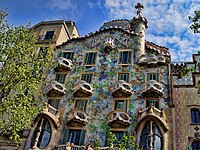 |
 |

|
|
| Name | Sagrada Família | Casa Batlló | Palau de la Música Catalana | Hospital de Sant Pau |
| Code, year | 320–005, 2005 | 320–006, 2005 | 804–001, 1997 | 804–002, 1997 |
| Coordinates | 41°24′19.8″N 2°10′30.2″E / 41.405500°N 2.175056°E | 41°22′00.3″N 2°09′59.0″E / 41.366750°N 2.166389°E | 41°23′16″N 2°10′30″E / 41.38778°N 2.17500°E | 41°24′50″N 2°10′30″E / 41.41389°N 2.17500°E |
Historic buildings and monuments
- Minor basilica of Sagrada Família, the symbol of Barcelona.
- Palau de la Música Catalana and Hospital de Sant Pau, designed by Lluís Domènech i Montaner, included in the UNESCO Heritage List in 1997.
- Works by Antoni Gaudí, including Park Güell, Palau Güell, Casa Milà (La Pedrera), Casa Vicens, Sagrada Família (Nativity façade and crypt), Casa Batlló, crypt in Church of Colònia Güell. The first three works were inscribed as a World Heritage Site in 1984. The other four were added as extensions to the site in 2005.
- The Cathedral of the Holy Cross and St. Eulalia (Gothic)
- Gothic basilica of Santa Maria del Mar
- Gothic basilica of Santa Maria del Pi
- Romanesque church of Sant Pau del Camp
- Palau Reial Major, medieval residence of the sovereign Counts of Barcelona, later Kings of Aragon
- The Royal Shipyard (gothic)
- Monastery of Pedralbes (gothic)
- The Columbus Monument
- The Arc de Triomf, a triumphal arch built for entrance to 1888 Barcelona Universal Exposition.
- Expiatory church of the Sacred Heart of Jesus on the summit of Tibidabo.
- The Historic Building of the University of Barcelona
Museums
Barcelona has a great number of museums, which cover different areas and eras. The National Museum of Art of Catalonia possesses a well-known collection of Romanesque art, while the Barcelona Museum of Contemporary Art focuses on post-1945 Catalan and Spanish art. The Fundació Joan Miró, Picasso Museum, and Fundació Antoni Tàpies hold important collections of these world-renowned artists, as well as the Can Framis Museum, focused on post-1960 Catalan Art owned by Fundació Vila Casas.
Several museums cover the fields of history and archaeology, like the Barcelona City History Museum (MUHBA), the Museum of the History of Catalonia, the Archeology Museum of Catalonia, the Maritime Museum of Barcelona, the Music Museum of Barcelona and the privately owned Egyptian Museum. The Erotic museum of Barcelona is among the most peculiar ones, while CosmoCaixa is a science museum that received the European Museum of the Year Award in 2006.[citation needed]
The Museum of Natural Sciences of Barcelona was founded in 1882 under the name of «Museo Martorell de Arqueología y Ciencias Naturales»[163][164] (Spanish for «Martorell Museum of Archaeology and Natural Sciences»). In 2011 the Museum of Natural Sciences ended up with a merge of five institutions: the Museum of Natural Sciences of Barcelona (the main site, at the Forum Building), the Martorell Museum (the historical seat of the Museum, opened to the public from 1924 to 2010 as a geology museum), the Laboratori de Natura, at the Castle of the Three Dragons (from 1920 to 2010: the Zoology Museum), the Historical Botanical Garden of Barcelona, founded 1930, and the Botanical garden of Barcelona, founded 1999. Those two gardens are a part of the Botanical Institute of Barcelona too.
The FC Barcelona Museum is the third most popular tourist attraction in Catalonia, with 1,51 million visitors in 2013.[165]
Parks
Barcelona contains sixty municipal parks, twelve of which are historic, five of which are thematic (botanical), forty-five of which are urban, and six of which are forest.[166] They range from vest-pocket parks to large recreation areas. The urban parks alone cover 10% of the city (549.7 ha or 1,358.3 acres).[65] The total park surface grows about 10 ha (25 acres) per year,[167] with a proportion of 18.1 square metres (195 sq ft) of park area per inhabitant.[168]
Of Barcelona’s parks, Montjuïc is the largest, with 203 ha located on the mountain of the same name.[65] It is followed by Parc de la Ciutadella (which occupies the site of the old military citadel and which houses the Parliament building, the Barcelona Zoo, and several museums); 31 ha or 76.6 acres including the zoo), the Guinardó Park (19 ha or 47.0 acres), Park Güell (designed by Antoni Gaudí; 17.2 ha or 42.5 acres), Oreneta Castle Park (also 17.2 ha or 42.5 acres), Diagonal Mar Park (13.3 ha or 32.9 acres, inaugurated in 2002), Nou Barris Central Park (13.2 ha or 32.6 acres), Can Dragó Sports Park and Poblenou Park (both 11.9 ha or 29.4 acres), the Labyrinth Park (9.10 ha or 22.5 acres), named after the garden maze it contains.[65] There are also several smaller parks, for example, the Parc de Les Aigües (2 ha or 4.9 acres). A part of the Collserola Park is also within the city limits. PortAventura World, one of the largest resort in Europe, with 5,837,509 visitors per year, is located one hour’s drive from Barcelona.[169][170] Also, within the city lies Tibidabo Amusement Park, a smaller amusement park in Plaza del Tibidabo, with the Muntanya Russa amusement ride.
Beaches
Barcelona beach was listed as number one in a list of the top ten city beaches in the world according to National Geographic[103] and Discovery Channel.[171] Barcelona contains seven beaches, totalling 4.5 kilometres (2+3⁄4 miles) of coastline. Sant Sebastià, Barceloneta and Somorrostro beaches, both 1,100 m (3,610 ft) in length,[65] are the largest, oldest and the most-frequented beaches in Barcelona.
The Olympic Harbour separates them from the other city beaches: Nova Icària, Bogatell, Mar Bella, Nova Mar Bella and Llevant. These beaches (ranging from 400 to 640 m (1,310 to 2,100 ft) were opened as a result of the city restructuring to host the 1992 Summer Olympics, when a great number of industrial buildings were demolished. At present, the beach sand is artificially replenished given that storms regularly remove large quantities of material. The 2004 Universal Forum of Cultures left the city a large concrete bathing zone on the eastmost part of the city’s coastline. Most recently, Llevant is the first beach to allow dogs access during summer season.
Other sights
-
-
-
The Roman and Medieval walls
-
-
-
-
-
-
-
-
-
-
-
-
-
-
-
Barcelona’s beach promenade in La Barceloneta and Somorrostro Beach
-
-
-
Barcelona’s old Customs building at Port Vell
-
-
International relations
Twin towns – sister cities
Barcelona is twinned with:[172]
Antwerp, Belgium (1997)
Athens, Greece (1999)
Boston, United States (1983)
Busan, South Korea (1983)
Cologne, Germany (1984)
Dublin, Ireland (1998)
Gaza City, Palestine (1998)
Havana, Cuba (1993)
Istanbul, Turkey (1997)
Kobe, Japan (1993)
Monterrey, Mexico (1977)
Montevideo, Uruguay (1985)
Montpellier, France (1963)
Rio de Janeiro, Brazil (1972)
Saint Petersburg, Russia (1985)
San Francisco, United States (2010)
São Paulo, Brazil (1985)
Sarajevo, Bosnia and Herzegovina (2000)
Shanghai, China (2001)
Tel Aviv, Israel (1998)
Tunis, Tunisia (1969)
Valparaíso, Chile (2001)
Partnership and friendship
Barcelona also cooperates with:[172]
Amman, Jordan
Guangzhou, China
Isfahan, Iran
Kyoto, Japan
Lampedusa, Italy
Lesbos, Greece
Maputo, Mozambique
New York City, United States
Ningbo, China
Paris, France
Rosario, Argentina
Saïda, Algeria
Seoul, South Korea
Tétouan, Morocco
Turin, Italy
Notable people
See also
- Outline of Barcelona
- Architecture of Barcelona
- Urban planning of Barcelona
- Street names in Barcelona
- List of markets in Barcelona
- List of tallest buildings in Barcelona
- Public art in Barcelona
- Mobile World Congress
- OPENCities
Notes and references
Notes
Citations
- ^ «Ajuntament de Barcelona». Generalitat of Catalonia. Archived from the original on 4 January 2017. Retrieved 13 November 2015.
- ^ «El municipi en xifres: Barcelona». Statistical Institute of Catalonia. Archived from the original on 24 November 2015. Retrieved 23 November 2015.
- ^ a b c d Demographia: World Urban Areas Archived 3 May 2018 at the Wayback Machine – Demographia, April 2018
- ^ a b Population on 1 January by broad age group, sex and metropolitan regions Archived 22 August 2016 at the Wayback Machine – Eurostat, 2017
- ^ Municipal Register of Spain 2018. National Statistics Institute.
- ^ THE BUDGET 2021
- ^ Barcelona: Población por municipios y sexo Archived 6 August 2016 at the Wayback Machine – Instituto Nacional de Estadística. (National Statistics Institute)
- ^ «2012 Global Cities Index». Archived from the original on 20 October 2013. Retrieved 30 March 2014.
- ^ Uecke, Oliver; De Cock, Robin; Crispeels, Thomas; Clarysse, Bart, eds. (2014). Effective Technology Transfer In Biotechnology: Best Practice Case Studies In Europe. Imperial College Press. p. 198. ISBN 9781783266821.
- ^ «The World According to GaWC 2020». GaWC — Research Network. Globalization and World Cities. Retrieved 31 August 2020.
- ^ «Port of Barcelona traffic statistics Accumulated data December 2013» (PDF). Statistics Service. p. 6. Archived from the original (PDF) on 14 June 2014. Retrieved 14 June 2014.
- ^ «AENA December 2018 Report» (PDF). 14 January 2019. Archived from the original (PDF) on 15 January 2019.
- ^ «First commercial trips» (in Spanish). Europapress.es. 10 December 2010. Archived from the original on 10 April 2014. Retrieved 30 March 2014.
- ^ Emerita: Revista de Lingüística y Filología clasica 11 (1943), p.468
- ^ Ptolemy, ii. 6. § 8
- ^ Gudmund Schütte (1917). Ptolemy’s Maps of Northern Europe: A Reconstruction of the Prototypes. H. Hagerup. p. 45. Retrieved 6 November 2015.
- ^ Smith, Sir William (1854). Dictionary of Greek and Roman Geography: Abacaenum-Hytanis. Boston, Massachusetts: Little, Brown and Company. p. 378.
- ^ Rufius Festus Avienius Ora Maritima « et Barcilonum amoena sedes ditium. » v514 Archived 12 August 2013 at the Wayback Machine
- ^ Gustav Parthey (1848). Itinerarium Antonini Avgvsti et Hierosolymitanvm: ex libris manvscriptis. F. Nicolai. p. 188. Retrieved 6 November 2015.
- ^ Petrus Wesseling; Hierocles (The Grammarian) (1735). Vetera Romanorum itineraria, /: sive Antonini Augusti Itinerarium. apud J. Wetstenium & G. Smith. p. 390. Archived from the original on 31 December 2015. Retrieved 6 November 2015.
- ^ Joel Cook (1910). The Mediterranean and Its Borderlands. p. 334. Retrieved 6 November 2015.
- ^ «Online Etymology Dictionary». Etymonline.com. Archived from the original on 9 April 2014. Retrieved 14 June 2010.
- ^ a b P.F. Collier & Son Corporation (1957). Collier’s Encyclopedia. Collier. p. 48. Archived from the original on 14 May 2016. Retrieved 14 May 2016.
- ^ «Ciutat Comtal» entry in Gran Enciclopèdia Catalana, Barcelona, Enciclopedia.cat, (in Catalan). [Retrieved 14 September 2019].
- ^ Servei d’Arqueologia of Institut de Cultura de Barcelona. «Caserna de Sant Pau del Camp». CartaArqueologica (in Spanish). Ajuntament de Barcelona. p. Description and Historical Notes. Archived from the original on 3 March 2016. Retrieved 2 May 2016.
- ^ MM Montaña; OV Campos; R Farré (2008). «Study of the Neolithic Excavation Site of the Sant Pau del Camp Barracks». Quarhis. II (4): 3. Retrieved 2 May 2016.[dead link]
- ^ Oros. vii. 143; Miñano, Diccion. vol. i. p. 391; Auson. Epist. xxiv. 68, 69, Punica Barcino.
- ^ «From Barcino to Barcelona».
- ^ Plin. iii. 3. s. 4
- ^ Inscr. ap. Gruter, p. 426, nos. 5, 6.
- ^ ii. 6
- ^ Avien. Ora Maritima. 520: «Et Barcilonum amoena sedes ditium.»
- ^ Paul. Dig. 1. tit. 15, de Cens.
- ^ «Roman walls, Barcelona». Bluffton.edu. Archived from the original on 23 July 2013. Retrieved 5 May 2009.
- ^ Welcome page in Catalan Archived 15 May 2019 at the Wayback Machine, Cathedral of Barcelona, (in Catalan). There is an English version of this page and website, as well as a Spanish one, but the word seu seems to be explained better in the Catalan version… [Retrieved 14 September 2019].
- ^ «Seu» Archived 4 November 2015 at the Wayback Machine, entry in the Diccionari Alcover-Moll, (in Catalan). [Retrieved 14 September 2019].
- ^ «GSM Barcelona — Barcelona History». GSM Barcelona. Retrieved 11 October 2022.
- ^ The Usatges of Barcelona: The Fundamental Law of Catalonia, ed. Donald J. Kagay, (University of Pennsylvania Press, 1994), 7.
- ^ Roger Collins, Caliphs and Kings, 796–1031, (Blackwell Publishing, 2012), 191.
- ^ T.N. Bisson (1986). «II. The age of the Early Count-Kings (1137–1213) (The Principate of Ramon Berenguer IV 1137–1162)». In Clarendon Press – Oxford (ed.). The medieval Crown of Aragon. A short story. p. 31. ISBN 978-0-19-820236-3.
- ^ Cateura Benàsser, Pau (2006). Els impostos indirectes en el regne de Mallorca (PDF). ISBN 978-84-96019-28-7. Archived from the original (PDF) on 3 October 2008. Retrieved 24 April 2008. El Tall dels Temps, 14. (Palma de) Mallorca: El Tall, 1996.
- ^ * González Arévalo (2019). «La esclavitud en la España Medieval. (siglos XIV-XV). Generalidades y rasgos diferenciales». Millars. Espai I Història. Castellón de la Plana: Universitat Jaime I (47): 16–17. ISSN 1132-9823.
- ^ González Arévalo 2019, p. 17.
- ^ The Bankers magazine, volume 11, page 595, J. Smith Homans Jr., New York 1857.
- ^ Chapter 15: A History of Spain and Portugal, Stanley G. Payne[dead link]
- ^ Adler, Ken (2002). The Measure of All Things: The Seven-Year Odyssey that Transformed the World. Abacus. ISBN 978-0-349-11507-8.
- ^ MHCB, City Council of Barcelona, Institute of Culture, SECC (2006). Juan Negrín 1892–1956. Barcelona, capital de la República. Barcelona. ISBN 84-96411-13-3. Archived from the original on 18 April 2018. Retrieved 17 April 2018.
{{cite book}}: CS1 maint: multiple names: authors list (link) - ^ Jordi Canal (2015). Historia mínima de Cataluña. Madrid: Turner Publicaciones S.L. ISBN 978-84-16142-08-8.
- ^ Decree of 5 April 1938.
- ^ «Barcelona (Spain)». Encyclopædia Britannica. Archived 13 October 2013 at the Wayback Machine
- ^ Taylor, Adam (26 July 2012). «How The Olympic Games Changed Barcelona Forever». Business Insider. Archived from the original on 19 August 2017. Retrieved 19 August 2017.
- ^ Usborne, Simon (18 August 2008). «After The Party: What happens when the Olympics leave town». The Independent. Archived from the original on 14 August 2017. Retrieved 19 August 2017.
- ^ Ferran Brunet i Cid (2002). «The economic impact of the Barcelona Olympic Games» (PDF). Universitat Autònoma de Barcelona. Archived from the original (PDF) on 19 April 2009. Retrieved 19 August 2017.
- ^ «Legacies of the Games» (PDF). International Olympic Committee. December 2013. Archived (PDF) from the original on 29 August 2017. Retrieved 19 August 2017.
- ^ Steven Mock (29 December 2011). Symbols of Defeat in the Construction of National Identity. Cambridge University Press. p. 274. ISBN 978-1-139-50352-5. Retrieved 22 October 2017.
- ^ Julius W. Friend (19 June 2012). Stateless Nations: Western European Regional Nationalisms and the Old Nations. Palgrave Macmillan. p. 97. ISBN 978-0-230-36179-9. Archived from the original on 6 May 2016. Retrieved 22 October 2017.
- ^ James Parkin; D. Sharma (1 January 1999). Infrastructure Planning. Thomas Telford. p. 173. ISBN 978-0-7277-2747-3. Retrieved 22 October 2017.
- ^ Ngiste Abebe; Mary Trina Bolton; Maggie Pavelka; Morgan Pierstorff (19 November 2013). Bidding for Development: How the Olympic Bid Process Can Accelerate Transportation Development. Springer. p. 3. ISBN 978-1-4614-8912-2. Archived from the original on 10 June 2016. Retrieved 22 October 2017.
- ^ The proportion of the population born outside of Spain rose from 3.9% in 2001 to 13.9% in 2006. «Guies Estadístiques: Barcelona en Xifres» (PDF). Ajuntament de Barcelona. November 2006. Archived from the original (PDF) on 20 February 2012. Retrieved 26 June 2010.
- ^ «At least 13 dead in van crash in Barcelona city center: media». Reuters. 17 August 2017. Archived from the original on 20 August 2017. Retrieved 19 August 2017.
- ^ Ward, Victoria. «Barcelona scene». telegraph.co.uk. The Telegraph. Archived from the original on 17 August 2017. Retrieved 17 August 2017.
- ^ «Barcelona and Cambrils: ‘Bigger’ attacks were prepared». BBC News. 18 August 2017. Archived from the original on 11 July 2018. Retrieved 20 July 2018.
- ^ «Diez años de Diada mediática». La Vanguardia (in Spanish). 11 September 2021. Retrieved 11 September 2021.
- ^ a b c «Barcelona». Gran Enciclopèdia Catalana. Vol. 3. Barcelona: Edicions 62. July 1971. pp. 193–229.
- ^ a b c d e «11 Barcelona.indd» (PDF). 15 January 2001. Archived from the original (PDF) on 20 February 2012. Retrieved 26 June 2010.
- ^ «Barcelona Spain Tibidabo Sagrat Cor Church. Full Screen QTVR panoramic image». Panoramas.dk. Archived from the original on 28 April 2009. Retrieved 5 May 2009.
- ^ Ahrens, C. Donald (2012). Meteorology Today: An Introduction to Weather, Climate, and the Environment, 10th Edition. Cengage Learning. ISBN 978-0840054999.
- ^ Viers, Georges (1987). Climatología [Climatology] (in Spanish). Barcelona: Oikos-Tau. ISBN 9788428102957., pp.166-167
- ^ «Valores Climatológicos Normales. Barcelona / Aeropuerto». Retrieved 6 April 2021.
- ^ a b «Weather2Travel.com: Barcelona Climate Guide». Archived from the original on 18 July 2011. Retrieved 16 June 2011.
- ^ «Valores climatológicos normales. Barcelona, Fabra». Retrieved 6 April 2021.
- ^ «Valores Climatológicos Normales. Barcelona / Aeropuerto». Archived from the original on 10 April 2014. Retrieved 16 June 2011.
- ^ «Barcelona Can Bruixa – climate (1987–2010) Barcelona.cat, Barcelona City Hall». Archived from the original on 24 January 2018.
- ^ «Valores climatológicos normales. Barcelona Aeropuerto». AEMET. Retrieved 6 April 2021.
- ^ a b c d «Ajuntament de Barcelona – Population, household and homes statistics» Archived 3 June 2017 at the Wayback Machine, retrieved 12 June 2017.
- ^ Departament d’Estadística. Ajuntament de Barcelona (2011). «Coneixement del català: Evolució de les característiques de la població de Barcelona (Knowledge of Catalan in Barcelona)». Ajuntament de Barcelona (in Catalan). Archived from the original on 31 December 2015. Retrieved 13 November 2015.
- ^ «Ajuntament de Barcelona: Estadística: Evolució de la població. 1900–2005». Archived from the original on 21 December 2007. Retrieved 26 June 2010.
- ^ Fundación BBVA. «La población de Barcelona» (PDF). Archived from the original (PDF) on 6 January 2010. Retrieved 6 May 2019.
- ^ Ajuntament de Barcelona (1 January 2017). «Poblacion por edades quinquenales y sexo. 2017». Archived from the original on 6 May 2019. Retrieved 6 May 2019.
- ^ «Evolució de la població estrangera a Barcelona. 2010–2019». Ajuntament de Barcelona. 1 January 2019. Archived from the original on 28 July 2019. Retrieved 28 July 2019.
- ^ Sian Preece (2016). The Routledge Handbook of Language and Identity. Routledge. p. 513.
- ^ «Barcelona’s Pakistani community» Archived 11 June 2017 at the Wayback Machine, retrieved 12 June 2017.
- ^ Conte-Helm, Marie. The Japanese and Europe: Economic and Cultural Encounters (Bloomsbury Academic Collections). A&C Black, 17 December 2013. ISBN 1780939809, 9781780939803. p. 111 Archived 15 February 2017 at the Wayback Machine.
- ^ a b Barcelona (4 June 2007). «La mitad de las mezquitas de Catalunya están en Barcelona». 20minutos.es. Archived from the original on 15 October 2015. Retrieved 8 October 2015.
- ^ a b c Digital, Protestante (7 July 2011). «España experimenta retroceso en catolicismo – El Mundo – Mundo Cristiano». CBN.com. Archived from the original on 17 July 2015. Retrieved 8 October 2015.
- ^ CIS (July 2019). «Postelectoral Elecciones Autonómicas y municipales 2019. Barcelona (Municipio de)» (PDF). Archived (PDF) from the original on 9 October 2022. Retrieved 27 September 2019.
- ^ a b «Estudio demográfico de la población musulmana» (PDF). Unión de Comunidades Islámicas de España. Archived (PDF) from the original on 27 May 2015. Retrieved 27 May 2015.
- ^ «The Jewish Virtual History Tour: Barcelona». Jewishvirtuallibrary.org. Archived from the original on 10 April 2014. Retrieved 27 August 2012.
- ^ «Barcelona: Directory: Theme: Religion». W3.bcn.es. Archived from the original on 5 October 2009. Retrieved 26 June 2010.
- ^ «Orthodox Church in Catalonia». Orthodoxengland.org.uk. Archived from the original on 17 June 2012. Retrieved 30 March 2014.
- ^ «Global city GDP rankings 2008–2025». Pricewaterhouse Coopers. Retrieved 16 December 2009.[dead link]
- ^ Urban Audit – CityProfiles: Barcelona – Eurostat, 2004 Archived 23 July 2013 at the Wayback Machine
- ^ «Best European business cities». City Mayors. 28 October 2009. Archived from the original on 23 July 2013. Retrieved 15 September 2011.
- ^ «The Monocle Quality of Life Survey 2015». Monocle. 2015. Archived from the original on 3 December 2017. Retrieved 25 November 2017.
- ^ «Independent city analysis and rankings for innovation in 2009». 2thinknow. Archived from the original on 9 April 2014. Retrieved 1 August 2009.
- ^ «A Luxury Lifestyle Is More Affordable In Spain Than Almost Anywhere Else In The World, Finds New Report». Gua. Retrieved 23 September 2020.
- ^ «Barcelona, recognised as the top Southern European city with future economic potential». Barcelona Growth. 5 March 2014. Archived from the original on 13 April 2014. Retrieved 11 April 2014.
- ^ «European Cities and Regions of the Future 2014/15». fDi Magazine. 17 February 2014. Archived from the original on 12 November 2014. Retrieved 11 April 2014.
- ^ «World Urban Forum 2004». Archived from the original on 15 March 2015. Retrieved 1 September 2017.
- ^ «Top 100 Cities Destination Ranking». blog.euromonitor.com. 21 January 2013. Archived from the original on 1 March 2016. Retrieved 24 March 2016.
- ^ «Irresistible cities: World’s 25 top tourism destinations». edition.cnn.com. Archived from the original on 7 April 2016. Retrieved 24 March 2016.
- ^ «Best Spanish Cities». Gospain.about.com. 25 March 2014. Archived from the original on 10 April 2014. Retrieved 30 March 2014.
- ^ a b «Top 10 Beach Cities». 8 July 2010. Archived from the original on 21 July 2010. Retrieved 30 July 2010.
- ^ Movie «Worlds Best Beaches», Discovery Channel 2005
- ^ «Los 10 mejores hoteles en Barcelona 2016 – TripAdvisor – Precios y opiniones». tripadvisor.es. Archived from the original on 23 March 2016.
- ^ «10 mejores hoteles de 5 estrellas en Barcelona – TripAdvisor». tripadvisor.es. Archived from the original on 7 April 2016. Retrieved 23 March 2016.
- ^ «20 Of The Safest Cities In The World». Business Insider. Archived from the original on 24 December 2016. Retrieved 12 December 2016.
- ^ «The 15 safest cities in the world». Business Insider. Archived from the original on 8 December 2016. Retrieved 12 December 2016.
- ^ Burgen, Stephen (25 June 2018). «‘Tourists go home, refugees welcome’: why Barcelona chose migrants over visitors». The Guardian. London. Archived from the original on 2 September 2018. Retrieved 3 September 2018.
- ^ Coffey, Helen (15 May 2017). «Eight Places That Hate Tourists the Most». The Independent. London. Archived from the original on 3 September 2018. Retrieved 3 September 2018.
- ^ Hunt, Ellen (17 July 2018). «Residents in tourism hotspots have had enough. So what’s the answer?». The Guardian. London. Archived from the original on 2 September 2018. Retrieved 3 September 2018.
- ^ Dogshun, Joe (7 March 2018). «Europe’s beauty spots plot escape from the too-many-tourists trap». The Guardian. London. Archived from the original on 1 September 2018. Retrieved 3 September 2018.
- ^ «Valor afegit brut a preus bàsics. Base 2000 Per sectors (%)» (en: «Gross value added at basic prices. Base by sector (%)«) Archived 10 April 2014 at the Wayback Machine – Idescat, 2008
- ^ «Valor afegit brut. Indústria per branques d’activitat (%)» (en: «Gross Value Added. Branches of industry (%)«) Archived 10 April 2014 at the Wayback Machine – Idescat, 2008
- ^ «:: GREC.NET -«. 6 March 2013. Archived from the original on 6 March 2013. Retrieved 18 August 2017.
- ^ «Die große Automobil-Enzyklopädie» – Harald H. Linz, Halwart Schrader, BLV, Munich 1986, ISBN 978-3-405-12974-3
- ^ «The Beaulieu Encyclopedia of the Automobile» – Nick Georgano, Fitzroy Dearborn Publishers, Chicago 2001, ISBN 978-1-57958-293-7
- ^ «NISSAN |CORPORATE INFORMATION |Outline of Company |Facilities Overseas |Europe». Nissan-global.com. Archived from the original on 19 April 2010. Retrieved 30 March 2014.
- ^ «Cómo llegar». Derbi. Archived from the original on 10 April 2014. Retrieved 30 March 2014.
- ^ Leticia Blanco (20 January 2009). «La feria de moda urbana Bread and Butter deja Barcelona». El Mundo. Archived from the original on 13 November 2013. Retrieved 22 July 2009.
- ^ EFE (23 January 2009). «El presidente del Bread&Butter confirma oficialmente que la feria abandona Barcelona». El Periódico. Retrieved 22 July 2009.
[Karl Heinz Muller, the entrepreneur behind B&B in announcing the move in a press conference held on January 23, 2009 said] No llores Barcelona, levántate y haz algo [don’t cry Barcelona, get up and do something about it] Barcelona in Europe is a metropolis of fashion.
- ^ «Paris Towers Over World of Fashion as Top Global Fashion Capital for 2015» Archived 6 June 2017 at the Wayback Machine, retrieved 12 June 2017.
- ^ a b «BOE – LEY 1/2006, de 13 de marzo, por la que se regula el Régimen Especial del municipio de Barcelona». Boe.es. 14 March 2006. Archived from the original on 30 April 2008. Retrieved 26 June 2010.
- ^ «Ajuntament de Barcelona> Ajuntament> El Govern de la Ciutat». W3.bcn.es. Archived from the original on 28 July 2010. Retrieved 26 June 2010.
- ^ «Ajuntament de Barcelona: Organització política». Bcn.cat. Archived from the original on 23 July 2013. Retrieved 26 June 2010.
- ^ «Ajuntament de Barcelona> Council> The city government> Council Executive». W3.bcn.es. Archived from the original on 22 January 2011. Retrieved 26 June 2010.
- ^ «Ajuntament de Barcelona> Council> The city government> Plenary». W3.bcn.es. Archived from the original on 15 April 2011. Retrieved 26 June 2010.
- ^ «Ajuntament de Barcelona> Council> The city government> Committees of the Municipal Council». W3.bcn.es. Archived from the original on 15 April 2011. Retrieved 26 June 2010.
- ^ «Agència de Salut Pública de Barcelona». www.aspb.cat. Archived from the original on 16 October 2014. Retrieved 9 October 2014.
- ^ «Ajuntament de Barcelona> Council> The municipal administration». W3.bcn.es. Archived from the original on 22 June 2010. Retrieved 26 June 2010.
- ^ «Best universities in Spain». Times Higher Education World University Rankings. 4 September 2020. Retrieved 13 February 2021.
- ^ «Best Global Universities in Spain». U.S. News & World Report Best Colleges Ranking. Retrieved 13 February 2021.
- ^ «Globalization and World Cities Study Group & Network – Inventory of World Cities». Archived from the original on 30 June 2007. Retrieved 7 July 2007.
- ^ Prim, Sara (11 December 2015). «Barcelona becomes a UNESCO City of Literature». www.catalannews.com. Archived from the original on 3 October 2018. Retrieved 3 October 2018.
- ^ «L’Auditori: OBC». Auditori.org. Archived from the original on 25 July 2011. Retrieved 26 June 2010.
- ^ Roberts, Nina (6 August 2006). «Catalan Musical Stew Keeps Barcelona Up All Night – New York Times». Barcelona (Spain): Travel.nytimes.com. Archived from the original on 10 January 2008. Retrieved 5 May 2009.
- ^ «Barcelona Never Sleeps». The Hoya. 23 March 2020.
- ^ Football Money League – Deloitte, 2011 Archived 2 April 2012 at the Wayback Machine
- ^ «Barcelona 2013 15th FINA World Championships». FINA. Archived from the original on 12 November 2013.
- ^ «110th Christmas Cup for Swimming». timeout.com/barcelona. Time Out. 12 December 2019. Retrieved 3 October 2021.
- ^ To 2009, home stadium of club is Estadi Olímpic Lluís Companys in Barcelona, today is Estadi Cornellà-El Prat lies in suburb of Barcelona, in El Prat de Llobregat.
- ^ Gelderloos, Peter (2009). To Get to the Other Side: a journey through Europe and its anarchist movements.
- ^ Gelderloos, Peter (2010). Anarchy Works.
- ^ «AENA December 2018 Report» (PDF). Aena.es. 14 January 2019. Archived from the original (PDF) on 15 January 2019. Retrieved 8 October 2015.
- ^ a b Port of Barcelona traffic statistics 2013 Archived 14 June 2014 at the Wayback Machine – Port de Barcelona, 2014
- ^ «Port de Barcelona» (in Spanish). Apb.es. Archived from the original on 5 October 2009. Retrieved 26 June 2010.
- ^ «Port Barcelona – Cruises». Portdebarcelona.cat. Archived from the original on 31 March 2014. Retrieved 30 March 2014.
- ^ «Barcelona estrena TGV» (in Catalan). Avui. 9 February 2008. Retrieved 11 July 2011.
- ^ «The last High Speed railway stretch between Barcelona and France has finally been unveiled after years of delays». Catalan News Agency. 8 January 2013. Archived from the original on 10 April 2014. Retrieved 27 January 2014.
- ^ «Integrated travel cards – Transports Metropolitans de Barcelona». tmb.cat. Archived from the original on 24 August 2016. Retrieved 19 December 2018.
- ^ «News related with the council plans for the tram network union». W3.bcn.es. Archived from the original on 3 October 2009. Retrieved 26 June 2010.
- ^ «Information of Tramvia Blau». Tmb.net. Archived from the original on 24 December 2009. Retrieved 26 June 2010.
- ^ «Barcelona Taxi Information». Barcelona.com. Archived from the original on 2 February 2014. Retrieved 28 January 2014.
- ^ «Invalid Host Specified». 8 December 2003. Archived from the original on 8 December 2003. Retrieved 21 July 2006.
- ^ «Noticies: Data d’inici 22 de març a les 14:00 h. Pots realitzar l’alta al servei a partir del dia 16/03/07». Bicing. Archived from the original on 29 October 2007. Retrieved 26 June 2010.
- ^ «Què és». Bicing. Archived from the original on 25 January 2010. Retrieved 26 June 2010.
- ^ «Notícies: El Biking ja té més de 50.000 abonats». Biking. Archived from the original on 3 October 2009. Retrieved 26 June 2010.
- ^ «The covered Rondes (by-pass)». Bcn.es. Archived from the original on 16 May 2009. Retrieved 26 June 2010.
- ^ «Gaudí’s Barcelona Basilica, La Sagrada Família, Reaches Its Final Stage of Construction – The Atlantic». The Atlantic. Archived from the original on 12 March 2017. Retrieved 1 February 2017.
- ^ Witold Rybczynski (2001). The Look of Architecture. Oxford University Press. pp. 94–. ISBN 978-0-19-515633-1.
- ^ «RIBA Royal Gold Medallists» (PDF). RIBA. Archived from the original (PDF) on 2 February 2014. Retrieved 28 January 2014.
- ^ The seventh element of Place World Heritage «Works of Antoni Gaudí» is the Crypt in Colònia Güell, which is located at Santa Coloma de Cervelló.
- ^ Què passa al Museu?, Actualitat del Museu, Notícies del Museu, 134 anys d’història, Museum of Natural Sciences of Barcelona, press release 25 September 2016 (in Catalan)
- ^ Miradas: Páginas de la historia, una obra inédita, exhibition at «Museo Cerralbo», Madrid, from 24 April to 24 May 2012 ((in Spanish)
- ^ «Catalan museums received 21.5 million visitors in 2013». www.catalannews.com. Retrieved 9 November 2021.[permanent dead link]
- ^ Parcs i Jardins, Institut Municipal. «Parcs i Jardins> Els Parcs> Els Parcs de Barcelona». Bcn.es. Archived from the original on 5 January 2010. Retrieved 26 June 2010.
- ^ Parcs i Jardins, Institut Municipal. «Parcs i Jardins> Els Parcs> Història> La ciutat i el verd». Bcn.es. Archived from the original on 3 October 2009. Retrieved 26 June 2010.
- ^ Parcs i Jardins, Institut Municipal. «Parcs i Jardins> Els Parcs> Història> La democràcia». Bcn.es. Archived from the original on 31 March 2009. Retrieved 26 June 2010.
- ^ Corporate responsibility report 2017 Archived 26 October 2018 at the Wayback Machine – investindustrial.com Archived 3 November 2018 at the Wayback Machine, 2018
- ^ The Global Attractions Attendance Report – Themed Entertainment Association, 2009 Archived 19 March 2012 at the Wayback Machine
- ^ Movie «Worlds Best Beaches», Discovery Channel 2005 Video on YouTube
- ^ a b «Direcció de Relacions Internacionals». ajuntament.barcelona.cat (in Catalan). Barcelona. Retrieved 2 August 2020.
Gerenal references
This article incorporates text from a publication now in the public domain: Smith, William, ed. (1854–1857). «Barcelona». Dictionary of Greek and Roman Geography. London: John Murray.
- «Barcelona». Gran Enciclopèdia Catalana. Barcelona: Ed. Enciclopèdia Catalana S.A.
- Busquets, Joan. Barcelona: The Urban Evolution of a Compact City (Harvard UP, 2006) 468 pp.
- McDonogh, G. W. (January 2011). «Review Essay: Barcelona: Forms, Images, and Conflicts: Joan Busquets (2005)». Journal of Urban History. 37 (1): 117–123. doi:10.1177/0096144210384250. S2CID 149302217.
- Marshall, Tim, ed. Transforming Barcelona (Routledge, 2004), 267 pp.
- Ramon Resina, Joan. Barcelona’s Vocation of Modernity: Rise and Decline of an Urban Image (Stanford UP, 2008). 272 pp.
External links
- Official website of Barcelona
- Official website of Barcelona in Spain’s national tourism portal

Написать сочинение в какой стране ты хочешь побывать я хочу побывать в Испании-Барселоне!
Только надо ОБЯЗАТЕЛЬНО написать на английском!
Даю 20 баллов за очень хороший ответ!
Светило науки — 19 ответов — 191 помощь
Theme: The country that i want to visit
It telling about place that I want to visit. I’m going to tell you about Spain and about city there Barselone.
But if you ask me why Spain? I said that this country very beautiful and bright. This country like other Europian countries has own history. Another reason why I want to visit this city, because there are carnaval festivals in Barselone and another Spanish cities. And there is a popular football team in Barselone.
I like this country and city because its they have anotheк people, another mentality, another rules and etc.
Обновлено: 11.03.2023
Красивейший город с богатой историей, удивительной архитектурой и насыщенной экскурсионной программой.
Кому-то Барселона, возможно, и «мимо сердца», а мне — по душе!
Мой отзыв о достопримечательностях Барселоны, в которых удалось побывать нам, и которые бы я рекомендовала к посещению.
Вот мой рейтинг самых значимых, самых популярных достопримечательностей Барселоны, с которых я советую ва начать своё знакомство с городом.
1. БУЛЬВАР РАМБЛА.
Самая известная пешеходная улица Барселоны — этакий «Арбат на испанский лад».
Масса уличных музыкантов, танцоров, художников и фокусников будут развлекать Вас, зарабатывая свои деньги.
Множество торговых точек повсюду, в которых можно купить массу полезных и бесполезных, но памятных вещей — от букета цветов до сувенира.
И, конечно же, именно здесь Вы сможете полюбоваться и сделать памятные снимки с всемирно известными «живыми скульптурами», которые являются «визитной карточкой» Рамбла.
Не пожалейте бросить им монетку — ведь и костюмы, и актёрское мастерство — всё на уровне!
На Рамбла расположена масса кафешек, тут же, прямо на улице в них можно вкусненько перекусить.
Непременно попробуйте настоящую испанскую паэлью под бокальчик сангрии и закусите хамоном!
М. Хамон. Какая вкуснятина! До сих пор для меня это лучший «сувенир», который могут мне привезти из Испании.
За хамоном и другими продовольственными покупками обязательно заверните с Рамбла на.
2. РЫНОК БОКЕРИЯ.
Здесь, хотя и многолюдно и недёшево, но лучший ассортимент свежайших продуктов — овощей и фруктов, мяса, рыбы и т. д., которого не встретишь, пожалуй, больше нигде в Барселоне.
А вот и он — ХАМОН.
Нагулявшись по гастрономическим достопримечательностям, уже можно продолжить знакомство с Барселоной через её архитектурные шедевры:
Великое произведение гениального Антонио Гауди, величественный Искупительный Храм Святого Семейства, который строится в течение вот уже 132 лет.
Говорят, что закончить строительство Правительство Испании планирует к 2026 году, к 100-летию со дня смерти архитектора.
Высота Храма Святого Семейства составляет 170 метров, чуть ниже него, на высоте 512 метров находится.
Здесь можно побывать в красивейшем Соборе Святого Сердца.
А также полюбоваться на Барселону с высоты птичьего полёта.
На Тибидабо есть неплохой парк аттракционов, в котором множество возможностей рассмотреть Барселону с высоты. Например, с колеса обозрения.
Если Вы ещё не бывали в океанариумах на Окинаве или в Атланте, и не избалованы океанариумами Сингапура, Дубай или соседней Валенсии, то, думаю, вам понравится общение с морскими обитателями в океанариуме Барселоны.
Разнообразный подводный мир представлен тут во всей красе — в 35 тематических аквариумах и 80-метровом тоннеле.
6. СТАДИОН КАМП НОУ.
У футбольных фанатов, уверена, это будет один из самых первых пунктов культурной программы в Барселоне. Но, уверяю Вас, современному человеку, даже далёкому от футбола, эта экскурсия также покажется интересной.
Здесь Вы сможете узнать об истории футбольного клуба Барселона, увидеть самые яркие её моменты, побываете в раздевалке, в душевой комнате великих футболистов, посидите в кресле тренера, сфотографируетесь с кубком, а также увидите многочисленные трофеи команды.
Для любителей религиозной темы в Барселоне достаточно большой выбор для посещений.
Вот сейчас я подумала о том, что описываю вам седьмой пункт, а это уже третья церковь!
В церковь Санта Мария Дель Пино мы забрели случайно, гуляя по Готическому кварталу, но атмосфера внутри нам понравилась.
8. МАГИЧЕСКИЙ ФОНТАН НА ПЛОЩАДИ ИСПАНИИ.
Поразит вас своими невероятными превращениями струй, подсеченных разными цветами и танцующих под красивейшую музыку.
Великолепное и очень эффектное зрелище! Рекомендую!
Небольшой, но очень милый парк, ещё одно творение вышеупомянутого Антонио Гауди. Знаменитые «пряничные домики».
Если подняться повыше, тут можно сделать панорамные фото Барселоны.
10. ДОМ БАЛЬО и ДОМ МИЛА — объединю их в один пункт.
В продолжение темы архитектуры и таланта Антонио Гауди.
Самые необычные, обращающие на себя внимание, и самые известные дома Барселоны.
Вот такая она — моя Барселона — один из самых моих любимых городов. Красивейший город, в котором столько интересных мест, что не то что посетить за один отпуск, а даже и не перечислить!
Тема по английскому языку: Мой любимый город – Барселона
Основная информация
Барселона – второй по величине город в Испании и столица автономной территории Каталонии. Она расположена на северо-восточном побережье Иберийского полуострова и омывается Средиземным морем. Население города составляет 1 621 537 человек. Барселона поделена на 10 административных районов, каждый со своим местным органом самоуправления. Это двуязычный город, где официальными языками являются каталанский и испанский.
Климат
В Барселоне средиземноморский климат с умеренными и влажными зимами и теплым, сухим летом. Когда в город приходят атлантические западные ветра, там нет дождей. Однако, в августе, сентябре, октябре и ноябре выпадает больше всего осадков. Самые сухие месяцы – февраль, март, июнь и июль.
Центр
Барселона – это важный финансовый, коммерческий, культурный и образовательный центр.
Экономика
Что касается здешней экономики, то имеется два главных сектора – промышленный и сфера обслуживания. Благодаря традиции искусства и ремесел, Барселона известна своим производственным дизайном.
Промышленность
Главные индустрии города – это текстильная, химическая, электронная, логистика, печатная, телекоммуникационная и некоторые другие. Аэропорт Барселоны – второй по величине аэропорт в Испании и самый большой на средиземноморском побережье. Барселона также является морским портом огромной коммерческой важности.
Сultural centre
Культуре Барселоны около 2000 лет. В городе большое количество театров и музеев. Самые известные из них – это Национальный театр Каталонии, Национальный музей искусства Каталонии, Барселонский музей современного искусства и некоторые другие.
Спорт
Заключение
Этот красивый испанский город действительно стоит посетить.
Barcelona
General information
Barcelona is the second largest city in Spain and the capital of Autonomous Community of Catalonia. It is situated on the northeast coast of the Iberian Peninsula and washed by the Mediterranean Sea. The population of the city is 1,621,537 people. Barcelona is divided into 10 administrative districts, each with its own council. It’s a bilingual city with Catalan and Spanish as official languages.
Climate
Barcelona has a Mediterranean climate with mild and humid winters and warm, dry summers. There are no rains when Atlantic west winds arrive in the city. August, September, October and November are the wettest months of the year. The driest are February, March, June and July.
Centre
Barcelona is an important financial, commercial, cultural and educational centre.
Economy
Regarding its economy, there are two main sectors – the manufacturing and the services. Due to Barcelona’s tradition of creative art and craftsmanship, the city is famous for its award-winning industrial design.
Main industries
The city’s main industries are textiles, chemical, electronic, printing, logistics, publishing, telecommunications and some others. Barcelona’s airport is the second largest airport in Spain, and the largest on the Mediterranean coast. Barcelona is also a big seaport of a great commercial importance.
Culture
Barcelona’s culture is about 2000 years old. There are a great number of theatres and museums in the city. The most famous are Teatre Nacional de Catalunya, the National Museum of Art of Catalonia, Barcelona Museum of Contemporary Art and some others.
Sport
Barcelona has a long-standing sporting tradition. Football club “Barcelona” is known all over the world for its football team as it’s one of the largest in Europe.
Это неповторимый, шумный город на юге Испании, столица Каталонии. Если вы поедете отдохнуть в эти прекрасные места, то никогда их не забудете и захотите возвращаться сюда снова и снова.
Потрясающая природа, архитектура А. Гауди, музеи, парки, национальная кухня и многое, многое другое увидели мы в этих неповторимых местах.
Вблизи города можно побывать на винодельческих хозяйствах.
В Барселоне вы увидите
собор Святого семейства, Саграда Фамилия,
который строится больше ста лет на пожертвования горожан. Он возвышается над городом и напоминает готический храм или остатки кораллового рифа.
Любители музеев обязательно посетите
музей Пабло Пикассо.
Именно в Барселоне открылся его талант. В музее представлены работы розового и голубого периода творчества.
Не забудьте побывать в
аквариуме Барселоны.
Он является самым большим в Европе. Восьмидесяти метровый туннель уходит вглубь Средиземного моря. Вы будете двигаться на эскалаторе, а вокруг вас будут плавать акулы, необычные рыбы и удивительные растения. Жители Барселоны проводят много времени в аквариуме, просто сидя на ступенях, спасаясь от жары и отдыхая в период полуденного зноя.
Около Барселоны можно посетить
монастырь Монжуиг
. Он построен прямо в горе в 1025 году, является религиозным символом,местом паломничества каталонцев. Здесь находится статуя святой Девы Марии,которую называют Чёрной Девой. Она сделана в 50 году до нашей эры. Со стен монастыря шикарный вид на Барселону. Монжуиг –это ещё и великолепный парк на высоте 213метров.
В городе красивые площади, парки, причудливые постройки, утопающие в зелени и цветах.
Ла Рамбла
-место, где ощущаешь большую любовь испанцев к неторопливым прогулкам.
Рассказ можно продолжать очень долго, есть ещё много мест, которые посетить за одну поездку просто невозможно!
Детская площадка в моём городе. В этом году, летом. Мой город — Мончегорск расцвёл. Покрасили много домов в яркие краски. Посадили на площади прекрасные,.
Стихи посвящённые 95 летию любимого города Мурманска от имени моей дочки МОЙ МУРМАНСК. Город Мурманск-мой родной, Я люблю тебя! Здесь живёт моя семья- Мама,папа,сёстры,я. Здесь хожу в любимый садик, Здесь мои.
Для тех, кто собрался провести свой отпуск в Барселоне и её окрестностях, или только обдумывает такой вариант, рассказываем самое важное и самое интересное об этом великолепном городе.
Барселона – второй по величине город Испании после её столицы Мадрида. Численность населения составляет 1,6 млн.чел. (вместе с пригородом — почти 5 млн.чел.) и это десятое место среди стран Евросоюза.
Город находится в 120 км от границы с Францией, в 200 км от Андорры. Омывается водами Балеарского моря, относящегося к акватории Средиземного моря.
Барселона является столицей автономной области Каталония (Catalunya).
Исторически Каталония и ее жители имеют мощные националистические идеи, получившие название каталонизм. На данный момент каталонцам удалось добиться автономии, официального статуса каталонского языка и признания каталонцев нацией, отдельной от испанцев. Предпринимаются попытки полного отделения от Испании и создания независимого государства. Опросы населения Каталонии показывают, что 80% выступают за независимость. Однако, власти Испании выступают категорически против отделения Каталонии, заявляют, что не признают никакие итоги референдума и не позволят выйти области из состава Королевства Испании.
Еще несколько интересных фактов о Барселоне вы можете узнать здесь .
Краткая история Барселоны
История Барселоны насчитывает более 2000 лет и ее истоки окутывают различные мифы и легенды. Одна из них, например, приписывает основание города Гераклу.
Более правдоподобно звучит версия о том, что примерно в 3 веке до н.э. карфагенский военачальник Гамилькар Барка на месте современного Готического квартала Барселоны разбил военный лагерь, который получил название Барсино (Барцино). Это и положило начало основанию города. До 2 века нашей эры значение города было невелико, поскольку по соседству с ним располагался более крупный Тарракон (Таррагона), но в конце концов он был вытеснен на второй план.
В средневековье город переходил во владение самых разных стран, его завоевывали римляне, вестготы, мавры (арабы). Барселона впитывала в себя культуру и архитектуру самых различных народов. Когда город разросся, то он получил название Барсинова (так его именовали вестготы), а позже оно было преобразовано в более мягкое – Барселона. Несколько веков Барселона фактически принадлежала Королевству Арагон, занимающее приморские территории западной части Средиземного моря в 10-15 веках. В 1516 году Арагон и Кастилия объединились в Королевство Испания, так закончилась реконкиста – длительный процесс отвоевания европейскими христианами (испанцами и португальцами) земель Пиренейского полуострова, занятых арабами.
После окончания реконкисты, Королевство Испания начало завоевание Америки и вскоре стала самым могущественным государством в Европе. Барселона была крупнейшим портом в королевстве и играла огромную стратегическую роль. Барселона и сегодня является важнейшим и крупнейшим портом на Средиземноморском побережье.
В 1888 и 1929 годах в Барселоне проводится Всемирная выставка (Expo), а в 1992 году город становится местом проведения Летних Олимпийских игр. Благодаря этим событиям в Барселоне появляется множество знаменитых достопримечательностей, город становится популярным туристическим центром.
Чем интересна Барселона?
Барселона – уникальный европейский город, успешно сочетающий в себе как культурно-исторический туризм, так и курортный. Подобных аналогов в Европе практически не имеется. Вдоль города протягивается 5-километровая пляжная песчаная полоса, свободная для посещения. Здесь расположились такие знаменитые пляжи Барселоны, как Барселонета, Сан-Себастьян и другие. В пригороде, на побережьях Коста-Брава и Коста-Дорада, расположено множество популярных во всем мире пляжных курортов: Бланес, Ситжес, Ллорет-де-Мар и др.
Благодаря богатейшей истории города и региона, Барселона – рай для любителей архитектуры и искусства. Десятки музеев, художественных галерей и невероятных достопримечательностей – Барселона не уступает по своей красоте и культурной значимости Парижу, Риму и другим европейским туристическим центрам.
В городе жил и творил архитектор Антонио Гауди, создавший множество интереснейших сооружений . А в городке Фигерас, в 140 км от Барселоны, родился и умер знаменитый Сальвадор Дали – теперь здесь расположен театр-музей Дали. В 110 км от Барселоны находится знаменитый Порт Авентура – самый посещаемый в Европе парк аттракционов!
Достопримечательности Барселоны: что посмотреть в городе?
Как говорилось выше, самыми популярными достопримечательностями города являются творения Антонио Гауди. Самое известное из них – визитная карточка Барселоны – Храм Святого Семейства (Sagrada Familia).
Ещё одним довольно популярным объектом, созданным Гауди, является Парк Гуэля.
Готический квартал – самый древний район города – сегодня отражает готическую архитектуру и немного римской.
Очень живописным местом является Старый порт Барселоны, недалеко от которого возвышается Монумент Христофору Колумбу.
На холме Монжуик в 1992 году проводились Олимпийские игры и с тех пор здесь находятся различные спортивные объекты, главным из которых является, разумеется, Олимпийский стадион. На этом же холме находятся популярные среди туристов Национальный дворец и Волшебный фонтан Монжуика – один из красивейших фонтанов в Европе.
А любителям футбола очень интересным наверняка покажется посещение Камп Ноу – стадиона знаменитого футбольного клуба Barcelona.
И это далеко не полный список достопримечательностей Барселоны.
Климат и погода в Барселоне
Благодаря южному расположению, климат Барселоны позволяет туристам восхищаться культурно-историческим наследием города круглый год. Зимой температура днем, как правило, не опускается ниже +10. Но самым популярным временем для посещения, разумеется, является лето, когда царствует курортный сезон. С мая по октябрь дневная температура держится выше +20. Море прогревается до комфортных температур в июне и держится до конца сентября.
Сколько стоит поездка в Барселону?
Из Москвы и Санкт-Петербурга прямые рейсы в Барселону традиционно выполняет испанская бюджетная авиакомпания Vueling. Стоимость билетов в среднем составляет 7-9 тысяч рублей в один конец. Отечественный лоукостер Победа также совершает полеты в Барселону и порой во время акций можно приобрести билеты за 5-6 тысяч рублей.
Разумеется, коронавирус внёс значительные коррективы в расписание рейсов в Барселону из России.
Найти авиабилеты в Барселону
За 60-80 евро в Барселоны можно вполне найти комфортный классический двухместный номер в отеле или снять квартиру. Ценителям бюджетного отдыха можно подыскать скромный номер и за 40-50 евро. Где остановиться в Барселоне?
Подробнее об организации самостоятельной поездки в Барселону можно прочитать здесь.
Траты на питание, сувениры, посещение достопримечательностей и прочие расходы – как известно, вопрос весьма субъективный.
В Барселоне много соблазнов и есть на что тратить деньги, но, в целом, цены не высокие, по меркам Европы. А цены в местных супермаркетах лично нас вообще приятно удивили. Если снять квартиру с кухней и готовить пищу самостоятельно, не питаясь в заведениях, то можно очень сильно сэкономить. У ваших покорных слуг такой возможности не было, поэтому мы питались, как правило, либо в тапас-барах, либо в фаст-фудах. В среднем, в сутки на все про все мы тратили 60 евро на двоих. В блоге вы можете прочитать наш подробный отзыв и фотоотчет о поездке в Барселону .
Религия и население
Подавляющее большинство жителей Барселоны считают себя каталонцами и исповедуют, как и все испанцы, католицизм.
Как уже неоднократно говорилось выше, каталонцам удалось добиться признания каталанского языка официальным. Он, конечно, во многом похож на испанский, но небольшие отличия в произношении и написании все же есть. В Барселоне, как и во всей Каталонии, идет мощная пропаганда каталонского языка. Все меню в кафе/барах/ресторанах, указатели и вывески, написаны, в первую очередь, на каталонском, а уже потом могут дублироваться на испанский или английский язык. Если перед своей поездкой вы выучите несколько фраз на испанском, то вас, разумеется, отлично поймут.
Владение английским языком среди населения Барселоны, как нам показалось, находится на относительно невысоком уровне. Конечно, если перед вами находится профессиональный гид или администратор крупного отеля или официант престижного ресторана, то он будет отлично говорить на английском, но если же речь идет о небольшом тапас-баре, которым владеет среднестатистический местный житель, то будьте готовы, что он может абсолютно не воспринимать английский язык, даже на уровне школьника-троечника:)
Кухня Барселоны представляет собой главным образом традиционную испанскую кухню с примесью местных, каталонских блюд. Гаспачо, паэлья из морепродуктов, сангрия, хамон – вот типичные гастрономические представители Барселоны.
Отношение к русским
Барселона – один из крупнейших туристических центров Европы и местное население уже давно привыкло к бесконечным потокам туристов с самых разных уголков Земли. Отношение к русским туристам здесь точно такое же, как и к представителям других наций, русофобии нами замечено не было. Каталонцы ведут себя сдержанно и держат своё мнение при себе:)
Многие наши соотечественника уехали в Барселону на ПМЖ, и если вдруг обслуживающий вас бармен, официант, работник рецепшена или хозяин, сдающий вам квартиру, оказался русским – удивляться не стоит.
Многие наши соотечественники, кстати, переезжая в Барселону, углубляются в изучение истории города и страны и переквалифицируются в туристических гидов — проводят интересные экскурсии на русском языке. О таких экскурсиях мы расскажем ниже.
Испания – член Евросоюза, денежная единица – евро.
Для посещения Барселоны необходима Шенгенская виза Испании или любого другого государства-члена Шенгенского соглашения
Каждый год, в последнее воскресенье марта, Барселона переходит на летнее время. В последнее воскресенье октября – на зимнее. Летом разница с Москвой составляет минус 1 час, зимой – минус два часа.
Экскурсии на русском языке
Как упомяналось выше, в Барселоне работает огромное количество наших соотечественников, которые с радостью проведут для вас личные или групповые экскурсии и расскажут действительно интересные факты и истории. В отдельной статье мы разобрали и посоветовали. самые лучшие, на наш взгляд, экскурсии.
Читайте также:
- Сочинение на тему цифры
- Как судьба человека связана с историей народа сочинение тихий дон
- Сочинение мое самое яркое впечатление
- Сочинение на тему песня снежинки
- В тупике ли герои пьесы на дне сочинение
10 Reasons Why Barcelona is my Favourite City
I often get asked where my favourite city is. It really is a tough question to answer, as I almost feel like a parent or teacher: you can’t have a favourite (“As each one is special in their own way”). But, let’s face it, I’m sure every parent and teacher deep down has a favourite child (even if they aren’t willing to admit it!). So with that honest and decisive attitude in mind, IF I had to choose, it would be Barcelona.
As a girl who grew up loving the beaches in Australia, but who also loves the vibe of a big city, it’s no wonder Barcelona is my favourite city to visit. Having visited 5 times (and counting!), it’s a city that I love and almost feel at home every time I return.
Everyone has their favourite; Guy has Paris, but Barcelona wins out for me every time.There’s so many things to do in Barcelona, and so much to love. Here’s 10 reasons why Barcelona is my favourite city and maybe you’ll fall in love with Barcelona too!
La Sagrada Família
Are you Pinspired? Hover over any of these images to Pin them!
- Reason 1. Sagrada Família. One of my favourite monuments in the world
- The Sagrada Família is unlike any other church
- A magnificent monument…
This has to be one of my favourite monuments in the world! If you visit Barcelona, and don’t visit Sagrada Família, all I can say is, “What are you doing?” Many people say that Barcelona has one of the highest crime rates in Spain, and frankly, not visiting the Sagrada Família would have to be the worst crime of all. I can confidently say it’s the most unique and amazing church in the world (and I think I’ve seen enough to say so!). I don’t care what your religious beliefs are, or if you have any at all, you need to go to Sagrada Família and be awed by Gaudí’s visions and architectural genius, which today are carried on by his successors.
- Full of space and natural light
- Amazing views to be had from the towers
- The ceiling represents a canopy of trees
Construction began on this stunning church in 1882 and it is still a work in progress. No, I didn’t get the date wrong; it has been in construction for 133 years! Due to be completed in 2026, the 100-year anniversary of Gaudí’s tragic and untimely death, this church is a must-see for any visitor. There is so much beauty, detail and symbolism present in the design and architecture of the church, I could easily spend hours exploring and admiring the work.
- The attention to detail is impressive
- One can spend hours exploring the intricate features
- Even the doors contain detail and testaments to Christ
What’s so interesting about ANOTHER European church, you say? Well, there are so many unique and intricate details, such as the insects and leaves on the door or the columns that were inspired by and designed to represent trees and a forest canopy. But the thing I absolutely love, love, love about the Sagrada Família is how the stained glass windows (which also have symbolism) are designed in a way that they completely wash the church in rainbows when the sun is at the right angle. I haven’t experienced or seen anything like this in any other church I have visited and get so excited to walk through, what seems like a huge rainbow kaleidoscope. The other thing I love is that, as it is still being built, each time I’ve visited I see new details or aspects. It’s an evolving monument.
- The stained glass windows were specially designed…
- to wash the church in rainbows and symbolism
The Gaudí collection
- 2. Gaudí’s work throughout the city is a highlight
- The rooftop of La Pedrera
- Cottage in Park Güell
I call this the collection, as there are quite a few sights to see, and can be an expensive and timely activity to do. So for that reason, if you are short on time, or cash, perhaps pick one or two (in addition to the Sagrada Família) to see.
- Park Güell is a lovely escape from the city
- Gaudí designed the park and the cottages
- Mosaics and curves galore
Park Güell is a lovely park (in case the name wasn’t obvious) that Gaudí designed for the Güell family in 1900. Gaudí was a big name of the modernisme or art nouveau and it is evident in this space. It’s like you are Hansel and Gretel and are visiting the witch’s gingerbread house. Thankfully, you won’t be eaten alive and the only fighting you’ll have to do is potentially against the hoards of tourists (especially in summer) for that perfect picture.
- Amazing colour and imagination
- Gaudí’s designs are easy to spot
- The rooftop of La Pedrera is a tourist’s highlight
Caso Batlló is another of my top picks to see, as the exterior and rooftop is unlike anything else. The roof is a colourful mosaic that could easily pass for a dragon curling around its prey. The windows also have unique details, that appear bone-like and there is not one corner inside the apartment building, as Guadí preferred soft curves in his designs. An innovative artist ahead of his time, Gaudí used natural light and clever engineering to create a special building that needs to be seen to be fully appreciated. La Pedrera (Casa Milá) is also a great visit; especially to see the rooftop.
Gaudí loved using nature as inspiration. His lizard in Park Güell is a popular attraction.
I’m such a fangirl of Gaudí and his artistic and innovative approach towards architecture and design, and visiting his buildings cemented my admiration for his genius.
Beaches
- Enjoy the city and the beach in Barcelona
- The beaches have some funky art
- And funky buildings
One of the things I love most about Barcelona, is that it has beaches. Now, they aren’t the best beaches I’ve visited, but they aren’t too shabby either. And in the height of summer, there’s nothing cooler than heading out of the city and straight to a chiringuito on the beach to party or chill out to the sounds of the waves and funky music. I especially love the contemporary art and architecture along the coast of Barceloneta and Vila Olímpica.
Montserrat
Breathtaking scenery at the monastery of Montserrat
Nestled in the mountains of Montserrat is a beautiful monastery dating back to 1025. At 1,236 metres high, the views overlooking the nearby villages are simply breathtaking and there are a number of trails for the walking enthusiast. It’s easy to visit in a day, however I would love to stay overnight to explore some of the more lengthy hiking trails and try some of the local produce. You can read more about Montserrat in a previous post here.
- A beautiful church in the mountains
- Never-ending views from the trails
- I feel on top of the world up here!
Montjuïc
Palau Nacional and the Magic Fountain of Montjuïc are a spectacular site to see
I can still clearly remember the day we visited MNAC (Museu Nacional d’Art de Catalunya), which is housed in the beautiful and impressive Palau Nacional, sitting high on Montjuïc. It was a rainy summer’s day and we decided to get our culture on. We got absolutely drenched to get there, so we were not only happy to enter this grand palace-like building for the art, but also just to dry off and get warm again! I’ll be honest, the collections weren’t as memorable as the building itself, but it is certainly worth a visit for lovers of art and architecture. We were actually lucky enough to see the Tour de France at the time we visited, as the course happened to pass through Barcelona (and Montjuïc) that day. If art museums aren’t your thing, the Magic Fountain of Montjuïc is a sight to see in its own right, especially when it is lit up at night. Sadly, we didn’t realise there was also the castle and cable car higher up on Montjuïc Mountain. I guess it means we will just have to go back to Barcelona to see it!
The funky districts (los barrios)
Barcelona is an attractive city, with unique districts
I can’t help but love the different districts in Barcelona. In general, Barcelona is laid out really well. The streets are generally wide and pedestrian-friendly, with a beautiful and open feel to them. Each district has its own ‘feel’ and defining characteristics, giving the explorer a different experience in each one. My favourites though, would have to be the Gothic Quarter (barri Gòtic), with its narrow streets, gothic architecture, arty stores, and a really cool and gritty vibe, and contrastingly, L’Eixample – known for its shopping, restaurants and clean, modernist architecture.
Food, glorious food!
Delicious desserts in Barcelona
Whilst it might not be as famous as other culinary capitals, the food in Barcelona is good. The city has no shortage of restaurants for all tastes; from decadent desserts to cutting-edge Michelin-star eats.
My favourite thing to do, is to head to La Boquería, the colourful and bustling food market at Ramblas, and pick up deliciously fresh €1 fruit juices. They are so refreshing and the flavour combinations are on point!
La Boquería has great fresh produce
There’s also the seafood. Now, I’m not a huge fan of seafood, normally preferring to eat the chips when it comes to fish n’ chips, however Guy is. We took a walk along Barceloneta to find some delicious restaurants where you get a decent amount of tasty (or so I am told) seafood for a small price. And whilst I may not enjoy the seafood, most restaurants here will have Crema Catalana (very similar to crème brulee) on the dessert menu – something that makes me a happy traveller.
If you are after some great value, make sure you keep an eye out for the ‘Menu del Día’ (Menu of the day), which is normally served at lunch. These are great value, offering normally three courses and a drink for under €20.
The ‘Arty’ scene
- Creative street performers on Las Ramblas
- Elaborate costumes and art to be seen throughout the city
- Art is everywhere in Barcelona
Speaking of Ramblas, in the height of summer, you can see street performers in elaborate and impressive costumes (just watch your valuables with all the crowds!). This strip is loud and busy at all hours and I love seeing the creative people and stores all around this area. Barcelona really embraces its art scene, and everywhere you turn, you can find incredible artistic expression throughout the museums, displayed on the buildings and streets and within the boutique stores.
Desigual
So this isn’t going to be a highlight for everyone, but I can say with all confidence and passion, that Desigual is my all-time favourite clothing brand. Sure it’s a little expensive and it’s no Dior or other high fashion brand made with the absolute best materials, but it’s unique (kinda like me, some would say!). I love the vibrant colours and patterns they use and how different their range is. I can spot someone wearing Desigual a mile away and always make it a priority to visit the Desigual stores (yes, you read it right, storeS) when I’m in Barcelona (and any other major city in Spain). Barcelona has the top pick though, as the brand is from Barcelona and has lots of stores, including outlets, (woo hoo!) dispersed throughout the city. In fact, I normally break up my sightseeing with various Desigual stops!
The Vibe
A city by the beach, engulfed in art and culture…
I feel a little guilty using a point so ambivalent, but really, there is just a cool vibe to Barcelona that I have not experienced anywhere else. In Barcelona cosmopolitan meets bohemian. There is a stark contrast between the modernist movement and the gritty, gothic streets. Funky bars and restaurants are dispersed throughout the clean and wide streets. The architecture is pleasing to the eye and the beaches are the perfect summer escape. Fashion is gospel, but undefined and open to interpretation. Where art, music and food are the heartbeat of the city, and are always pushing the boundaries.
Now I’ve heard by many people that Barcelona is dangerous and one of the worst cities in Europe for pickpockets. And I don’t doubt it; there are a lot of shady people and it can be very crowded and touristy. My best piece of advice is to travel smart, keep your valuables extremely close and accountable at all times and always be aware of your surroundings. We’ve been very fortunate to not have any instances of theft in the five times we’ve been there (but that’s not to say that we haven’t been solicited for drugs or prostitutes around Ramblas and the Gothic Quarter!).
Don’t forget to Pin any of the pics that Pinspired you!
Have you been to Barcelona? Did you love it or hate it and why? Comment below!
Follow my blog with Bloglovin
The following two tabs change content below.
- Bio
- Latest Posts
Land-Dwelling Mermaid, Hispanophile and travel addict. Kim-Ling one day hopes to convince Guy to build her a room for her huge shoe collection.
Барселона — второй по величине город в Испании и столица автономной территории Каталонии. Она расположена на северо-восточном побережье Иберийского полуострова и омывается Средиземным морем. Население города составляет 1 621 537 человек. Барселона поделена на 10 административных районов, каждый со своим местным органом самоуправления. Это двуязычный город, где официальными языками являются каталанский и испанский.
В Барселоне средиземноморский климат с умеренными и влажными зимами и теплым, сухим летом. Когда в город приходят атлантические
западные ветра, там нет дождей. Однако, в августе, сентябре, октябре и ноябре выпадает больше всего осадков. Самые сухие месяцы — февраль, март, июнь и июль.
Барселона — это важный финансовый, коммерческий, культурный и образовательный центр.
Что касается здешней экономики, то имеется два главных сектора — промышленный и сфера обслуживания. Благодаря традиции искусства и ремесел, Барселона известна своим производственным дизайном.
Главные индустрии города — это текстильная, химическая, электронная, логистика, печатная, телекоммуникационная и некоторые другие. Аэропорт Барселоны — второй по величине аэропорт в Испании и самый большой на средиземноморском побережье. Барселона также является морским портом огромной коммерческой важности.
Культуре Барселоны около 2000 лет. В городе большое количество театров и музеев. Самые известные из них — это Национальный театр Каталонии, Национальный музей искусства Каталонии, Барселонский музей современного искусства и некоторые другие.
Барселона поддерживает долголетние спортивные традиции. Футбольный клуб «Барселона» известен во всем мире своей футбольной командой и является одним из крупнейших в Европе.
Этот красивый испанский город действительно стоит посетить.
Перевод на английский язык
Barcelona is the second largest city in Spain and the capital of Autonomous Community of Catalonia. It is situated on the northeast coast of the Iberian Peninsula and washed by the Mediterranean Sea. The population of the city is 1,621,537 people. Barcelona is divided into 10 administrative districts, each with its own council. It’s a bilingual city with Catalan and Spanish as official languages.
Barcelona has a Mediterranean climate with mild and humid winters and warm, dry summers. There are no rains when Atlantic west winds arrive in the city. August, September, October and November are the wettest months of the year. The driest are February, March, June and July.
Barcelona is an important financial, commercial, cultural and educational centre.
As for its economy, there are two main sectors — the manufacturing and the services. Due to Barcelona’s tradition of creative art and craftsmanship, the city is famous for its award-winning industrial design.
The city’s main industries are textiles, chemical, electronic, printing, logistics, publishing, telecommunications and some others. Barcelona’s airport is the second largest airport in Spain, and the largest on the Mediterranean coast. Barcelona is also a big seaport of a great commercial importance.
Barcelona’s culture is about 2000 years old. There are a great number of theatres and museums in the city. The most famous are Teatre Nacional de Catalunya, the National Museum of Art of Catalonia, Barcelona Museum of Contemporary Art and some others.
Barcelona has a long-standing sporting tradition. Football club «Barcelona» is known all over the world for its football team as it’s one of the largest in Europe.
This nice Spanish city is really worth visiting.



